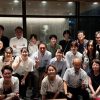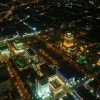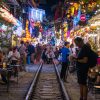Date of Issue:December 23, 2020
・Activity 1 / Round Table Discussion Vol. 64 @ZOOM(2020.08.28)
・Activity 2 / City Night Walk Vol. 66 with Small Group (2020.10-11)
・Activity 3 / Round Table Discussion Vol. 65 @ ZOOM (2020.11.28)
・Activity 4 / Light-Up Workshop in Akiu Onsen (2020.11.18)
Round Table Discussion Vol. 64 @ZOOM
“Rethinking Future City Night Walk”
2020.08.28 東悟子
The Lighting Detectives’ main activities revolve around fieldwork. During this salon, we split into groups to discuss what kinds of night walk surveys are possible during the COVID-19 pandemic, and what we should be observing now.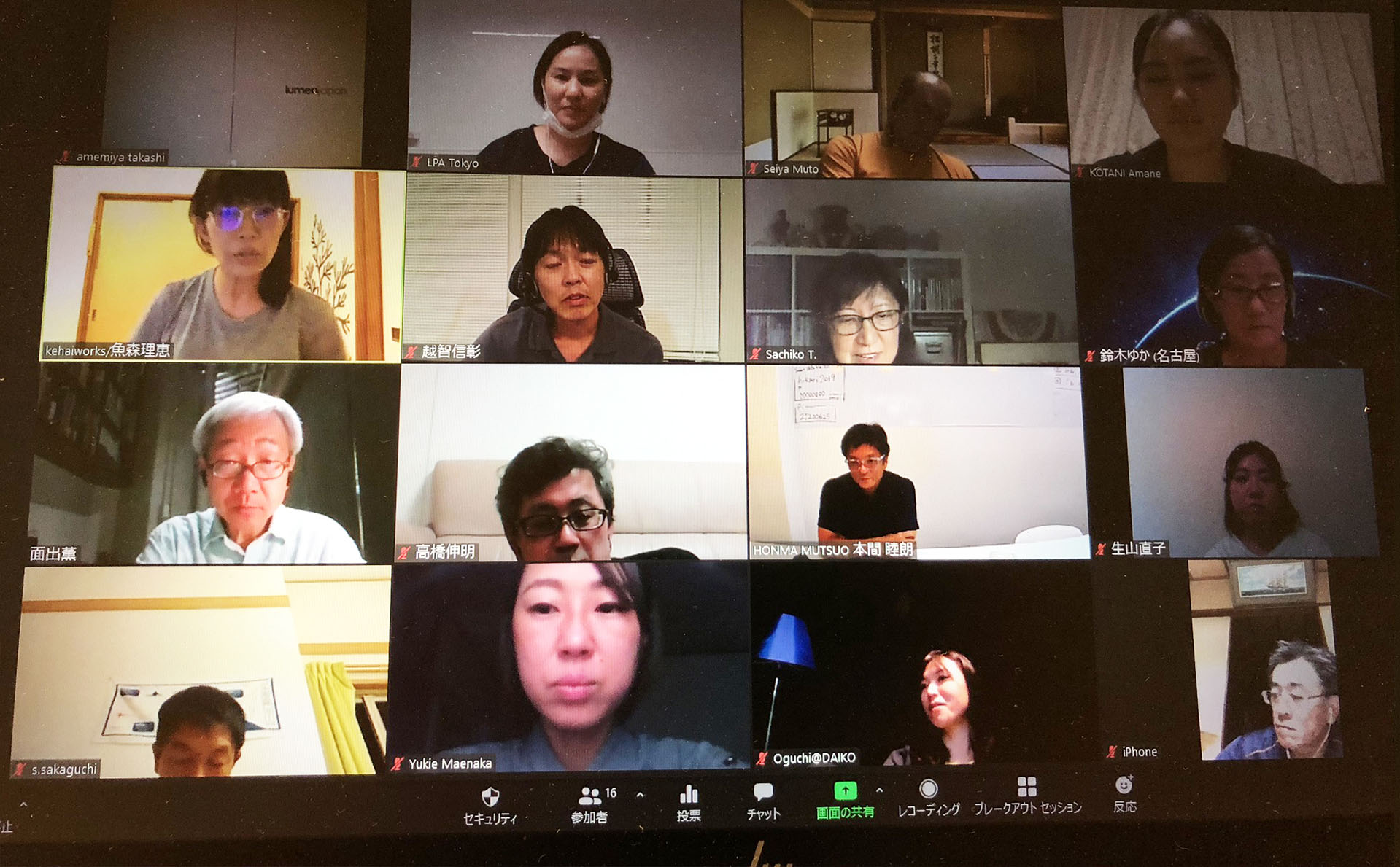 Our third salon held online
Our third salon held online
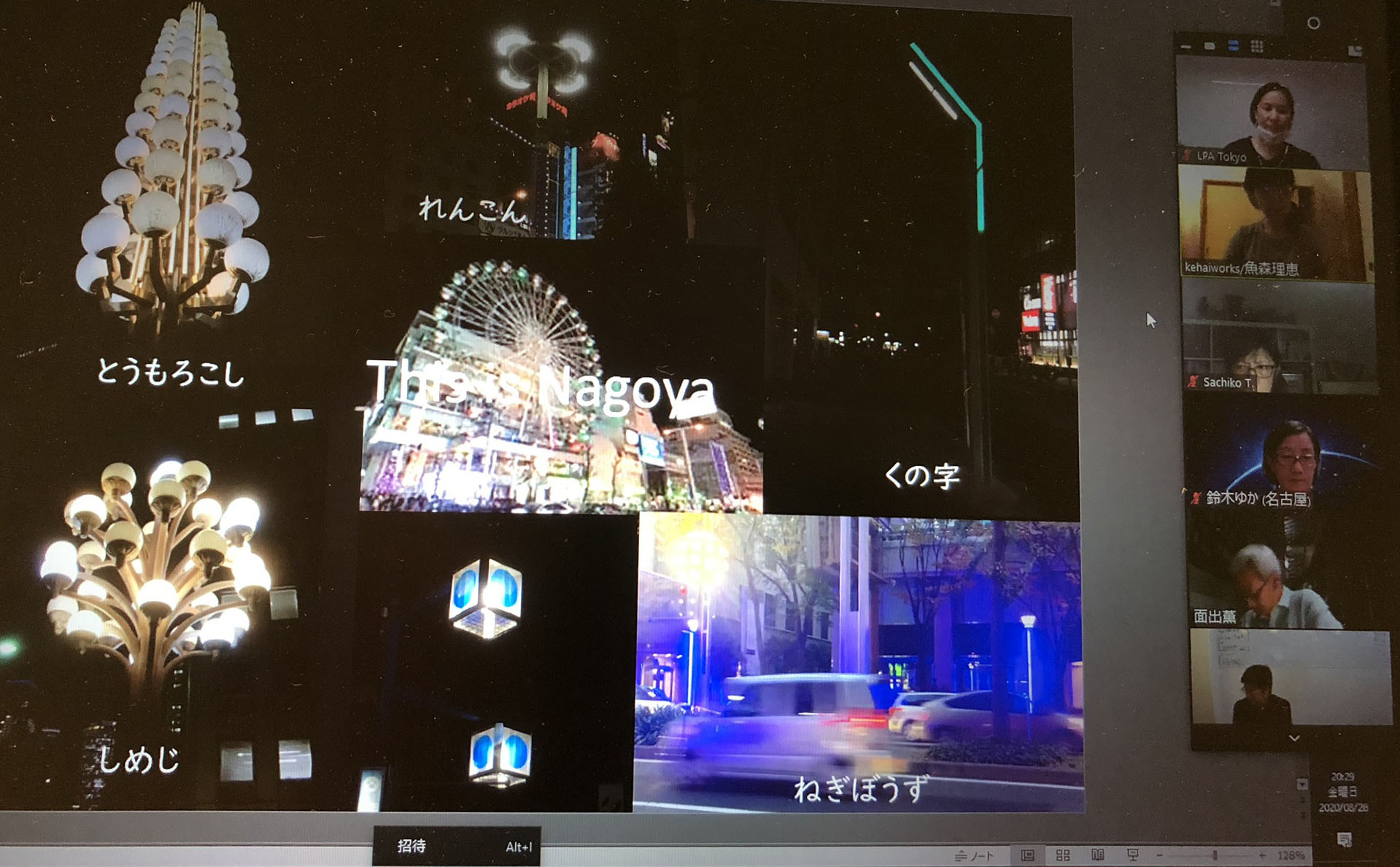 Each team discussed potential areas for the night walk survey. The Nagoya team proposed a streetlight investigation
Each team discussed potential areas for the night walk survey. The Nagoya team proposed a streetlight investigation
Since the end of March, we’ve been working with the night walk survey planning committee, SQUAD, to explore what kind of activities the Detectives can pursue even under pandemic restrictions.
Various ideas were proposed, such as solo night walks, video streams of night walks by Chief Mende, virtual night walks, and even group YouTube watch sessions.
In May, we conducted an experiment where each member investigated lighting within a 100-meter radius of their home and shared their findings online. This project turned out to be meaningful, as it revealed both positive aspects and problem areas in each of our residential neighborhoods.
However, since the Lighting Detectives have long focused on gathering for fieldwork as a core activity, we wanted to explore new possibilities. With that in mind, we invited members to submit ideas under the theme “Reimagining Future Night Walk Surveys.” Specifically, we asked what kind of night walk surveys they’d like to try.
Based on similarities in proposed themes and locations, members were grouped into three teams:
1. Kansai/Tokai team
2. Tokyo’s Old Neighborhoods & Traditional Shopping Streets team
3. Tokyo Light Pollution & New Urban Development team
Each group was given 40 minutes to discuss and develop ideas for both the theme and area of their proposed night walk survey. Afterwards, all groups shared their proposals with the full gathering, and we proceeded to decide which night walk surveys would actually be carried out.
The Kansai/Tokai area team proposed investigating the extravagant streetlights in Sakae, Nagoya, and the Midosuji illuminations. The Shopping Street team suggested surveys on the ambient lighting in the traditional neighborhoods of Yanaka and Azabu-Juban—and for some reason, even a cemetery lighting survey. The Light Pollution & New Urban Development team came up with several ideas: a tour of Shibuya’s public restrooms and Miyashita Park, the Toyosu area with its Olympic-related facilities, and the rapidly redeveloping area around Tachikawa Station.
Each survey was to be limited to a maximum of five participants, who could sign up for their preferred location. Unlike typical night walk surveys where around 25 members gather in one location and split into groups for on-site investigation and same-day reporting, this time, participants conducted their surveys on different dates. The results were later shared in an online salon. This format allowed participants to choose locations based on their own interests, giving them more ownership of the experience—and naturally, expectations were high.
In addition to planning these future walks, this salon also featured a member’s presentation on environmentally sensitive streetlighting initiatives on Kozushima Island. Inspired by this, an idea emerged to organize a night-watching tour there once COVID restrictions ease.
The online format of the salon made it easy for everyone to participate comfortably and voice their opinions. Because it lowers barriers to involvement and allows participation from anywhere, we hope to continue hosting salons online even after the pandemic. If you have any ideas for interesting salon topics, feel free to send them to the secretariat. (Noriko Higashi)
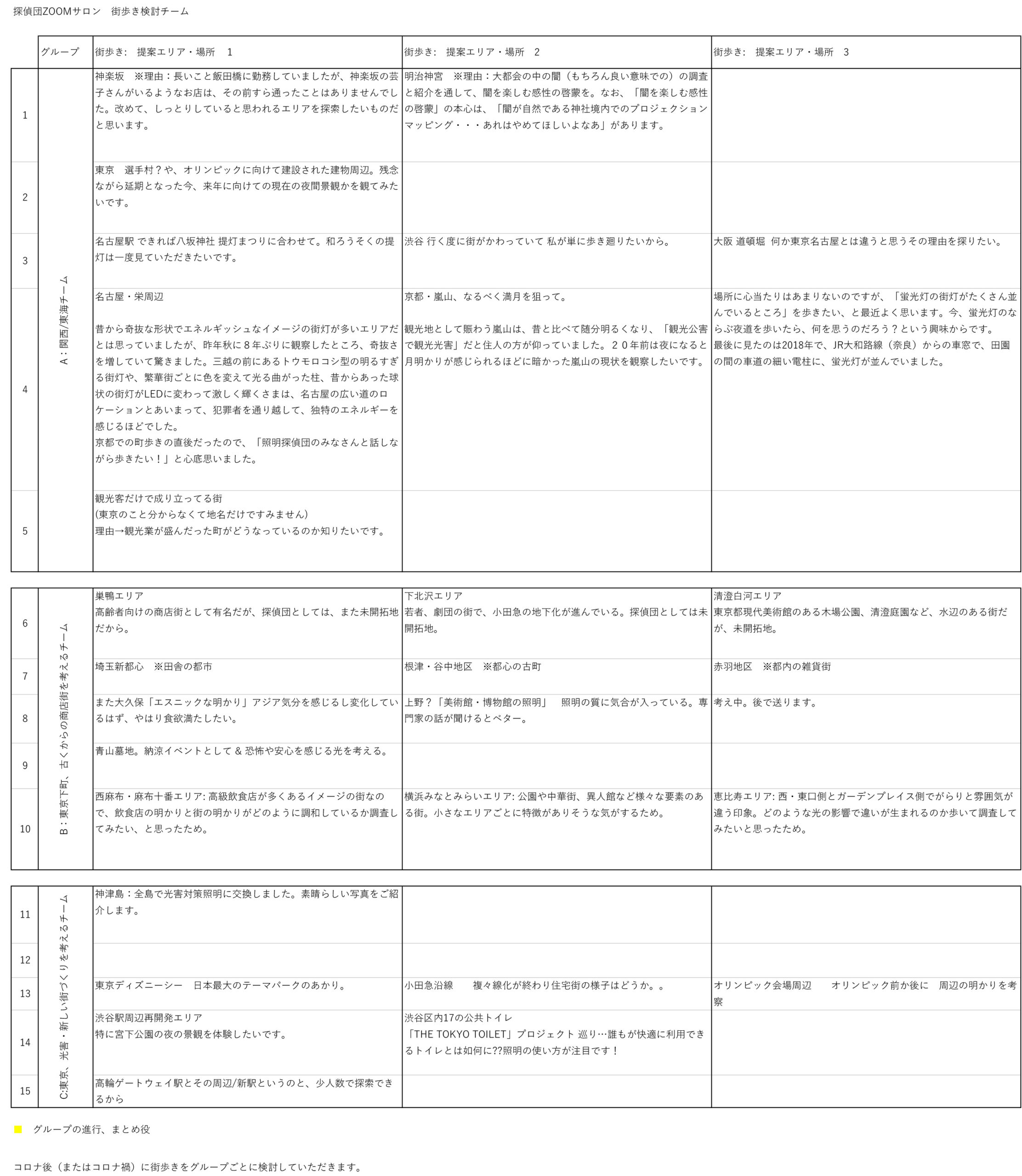
Based on the responses from the preliminary survey, the opinions were compiled and teams were organized accordingly.
City Night Walk Vol. 66 with Small Groups
Let’s explore the city in teams of up to five!
2020.Oct.- Nov. Tomoya Furukawa + Naoko Oguchi + Shinichi Sakaguchi + Shinichi Sakaguchi + Takashi Amemiya + Yuka Suzuki + Amane Kotani
To prevent the spread of COVID-19, we held a “Small Group” night walk survey in seven locations —including Kansai—limiting each group to a maximum of five participants. It was our first walk in a year. With the pandemic, had the vibrancy of the city at night changed?
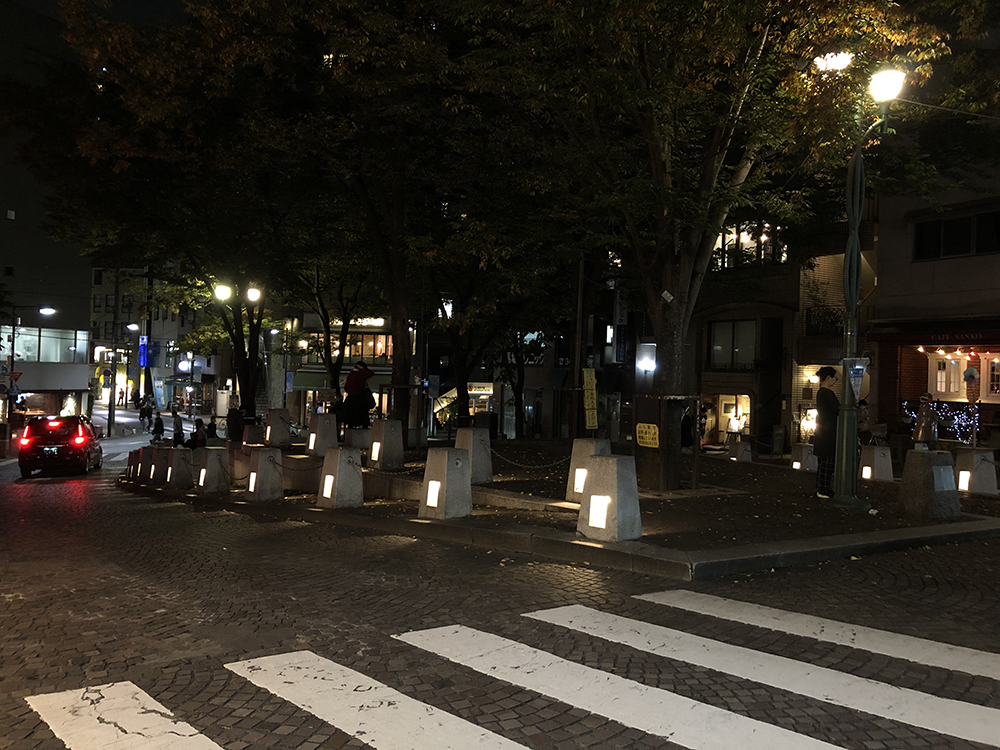
Patio Juban – The warm glow of the bollard lighting harmonizing with the gradually turning leaves of the zelkova trees created a pleasantly inviting atmosphere
Based on the results of the “Future Detective Night Walk Planning Salon” held at the end of August, we organized seven small-group night walk surveys from late October to mid-November, each with up to five participants. We selected seven areas—five in Tokyo, plus Nagoya and Osaka—and participants chose their preferred locations. It was our first night walk in a year, and we were reminded of the joy of seeing things firsthand and exchanging opinions on-site with fellow members. Each area had its own theme, allowing us to explore the unique characteristics of each neighborhood.
■Azabu-Juban – Motoazabu – Nishi-Azabu
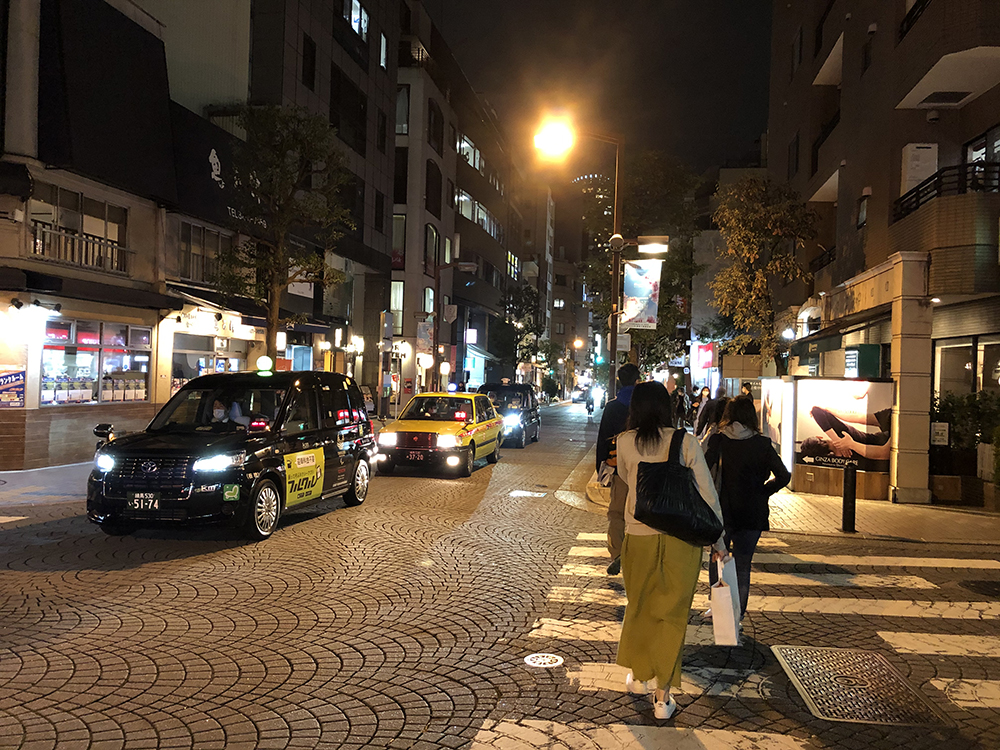 Azabu-Juban Odori – The warm orange lighting beautifully reflected off the stone pavement, creating a cozy and inviting ambiance
Azabu-Juban Odori – The warm orange lighting beautifully reflected off the stone pavement, creating a cozy and inviting ambiance
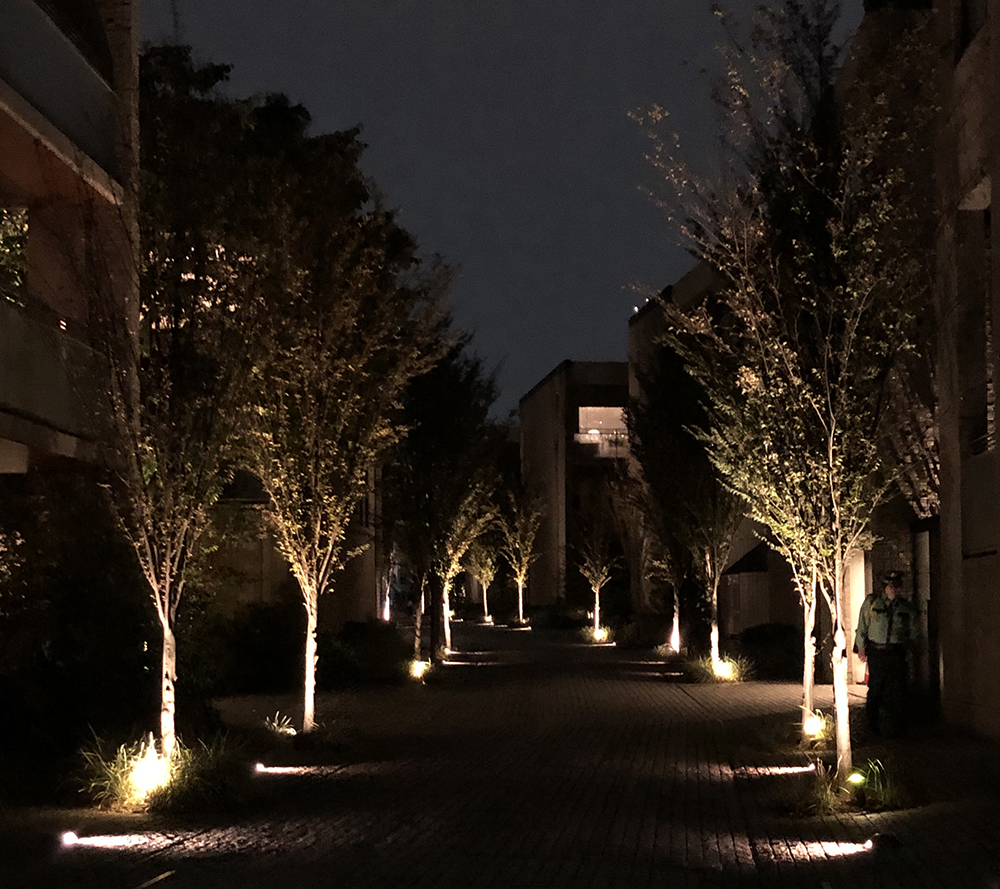 Low-rise luxury residences – The illuminated grounds exuded an air of sophistication and elegance
Low-rise luxury residences – The illuminated grounds exuded an air of sophistication and elegance
Azabu-Juban, a district blending tradition and modernity, originated as a temple town around Zenpuku-ji Temple, founded by Kukai in the medieval period. Today, it is home to many longestablished shops, temples, and several embassies. Five members gathered at Azabu-Juban Station to begin their investigation.
Along Azabu-Juban’s busiest street, Azabu-Juban Odori, old-fashioned shops stand side by side, with a mix of new and old lighting energizing the area. The orange glow from the street lamps reflects warmly on the cobblestone pavement, creating a cozy and inviting nighttime environment.
However, the street lamps along Zoshiki-dori, where a famous traditional wagashi (Japanese sweets) shop is located, emit white light. This causes noticeable glare, making the area feel harsh and unsettling, detracting from the stylish image of the neighborhood.
The community relaxation space, “Patio Juban,” features warm lighting from stone lantern-style bollard lights. These lights effectively enhance both pedestrian and vehicle safety while creating a beautiful nighttime landscape. The illumination harmonizes pleasantly with the turning-colored zelkova trees, earning unanimous praise as a “hero” lighting element. Soft lighting warmly welcomes residents returning to their apartment entrances, and the use of indirect lighting enhances the openness of the buildings’ façades—both also regarded as “heroes.” On the other hand, excessive light leaking from the interior of a ladies’ select shop and the strong, white floodlight-style illumination at Ajiro Park were criticized as examples of light pollution.
Climbing Daikoku-zaka slope, we entered the quiet, upscale residential area of Moto-Azabu. The overall amount of light in the neighborhood—including homes and streets—was kept restrained, with carefully placed pools of light that enhanced the presence, elegance, and aesthetics of the residences, creating a rich and comforting atmosphere. However, the overly bright lighting at a building entrance caused headaches and was unanimously judged a “villain.” This unique district blends nostalgic and stimulating lighting, where tradition and modernity coexist side by side. Everyone agreed that with better organization and integration, it could become an even more charming neighborhood. (Tomoya Furukawa)
■Shibuya – Touring Public Restrooms Designed by Designers
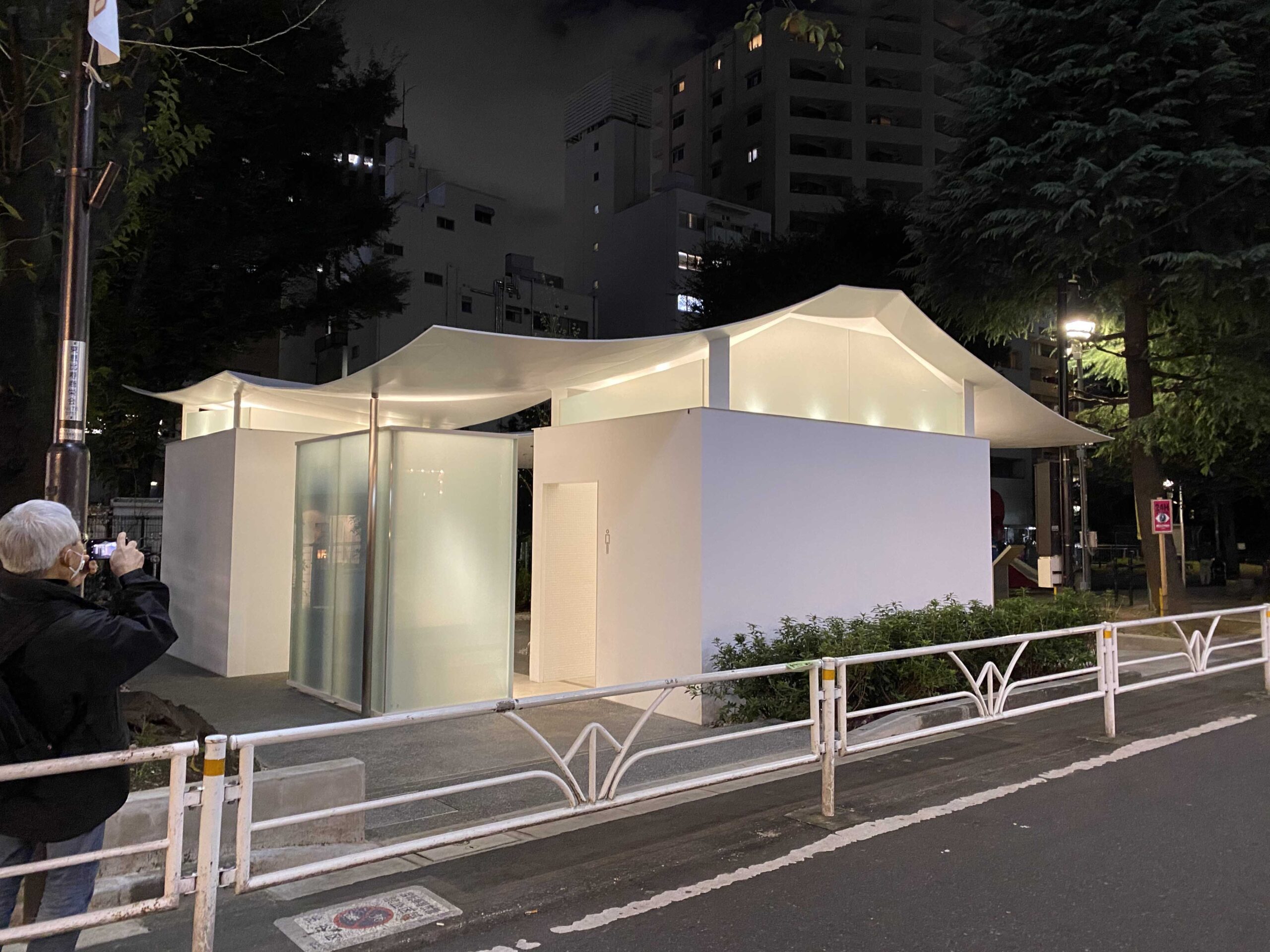
Ebisu East Park Toilet designed by Mr. Fumihiko Maki – Hero
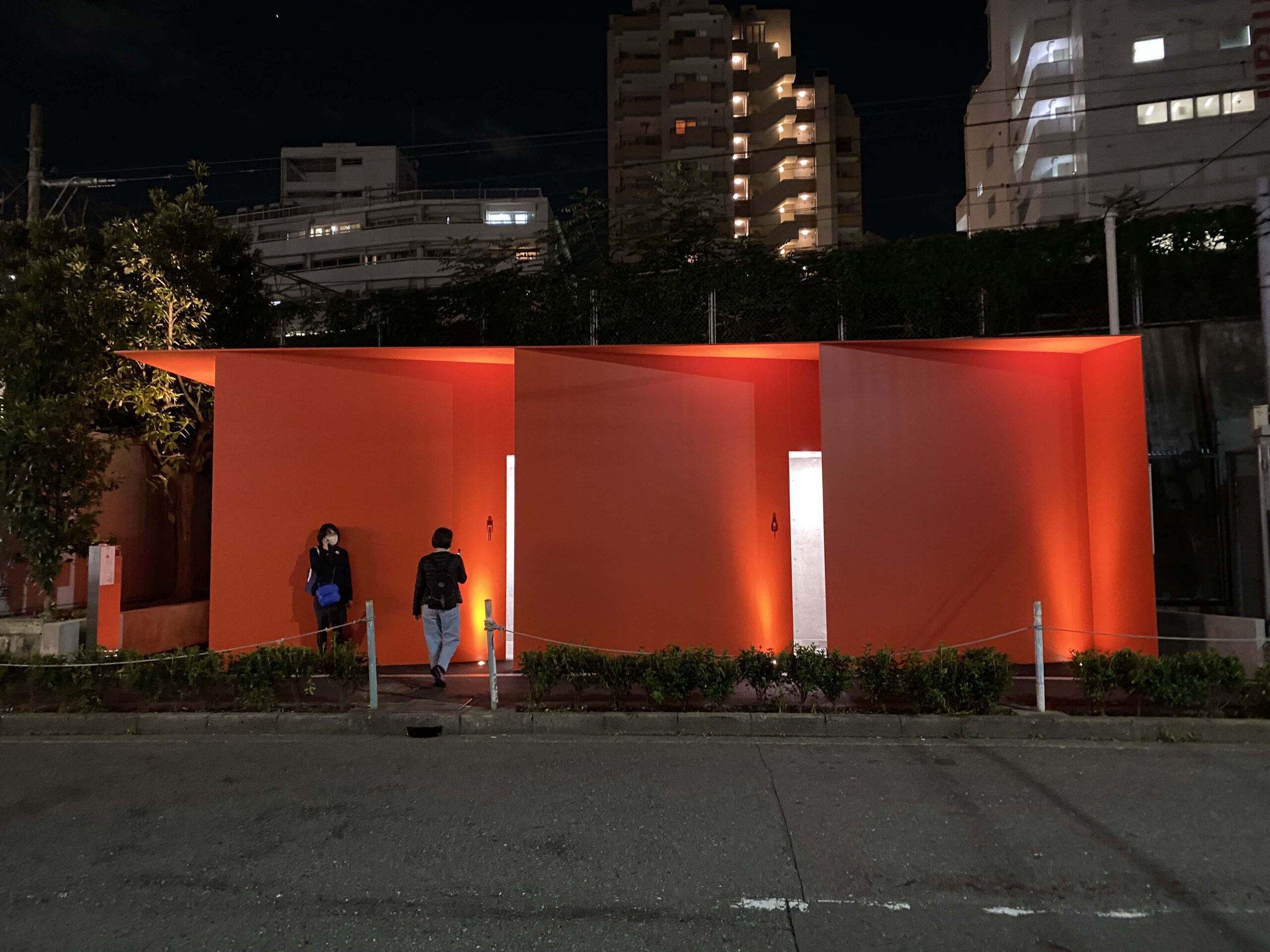 Higashi Sanchome Restroom designed by Ms.Naho Tamura
Higashi Sanchome Restroom designed by Ms.Naho Tamura
The Shibuya team began by visiting THE TOKYO TOILET project, a public restrooms initiative led by the Nippon Foundation. Each facility had a strikingly unique design, yet they all successfully broke away from the traditional image of public restrooms. All of them were impressively clean, well-lit, and clearly designed with safety in mind. The restroom in Ebisu Park, designed by Mr. Katayama, featured simple walls with indirect lighting and soft illumination at the feet, creating an inviting atmosphere that sparked curiosity about the space inside. Mr. Tamura’s design in Higashi Sanchome stood out with its bold red exterior walls and dramatic uplighting. Among them, the restroom at Ebisu East Park, designed by Mr. Maki, was particularly well received. Despite its unique form, it employed only bracket lighting to create a gentle, welcoming light environment, earning the title of “hero.” However, the parks surrounding many of these restrooms tended to have high color temperature lighting with low brightness, which made them feel somewhat unsafe. This highlighted the need for lighting plans that consider not just the restroom itself but the surrounding park area as well.
Next, the team visited MIYASHITA PARK, which opened this July. On the first floor, Shibuya Yokocho stood out with its energetic red lighting from lanterns and shop signs, creating a festive and lively atmosphere. This sense of excitement earned it the title of “hero.” The park’s concept of “MIX & MEET” is clearly expressed through bold choices—such as placing high-end brand shops beneath a public park—which effectively captures the essence of Shibuya. However, there were mixed opinions regarding the brightness of the shops and the large staircase; some felt the lighting was excessive. Including the Tokyo toilet project, the experience reinforced the feeling that Shibuya’s ongoing redevelopment deserves continued exploration through future lighting detective surveys. (Naoko Oguchi)
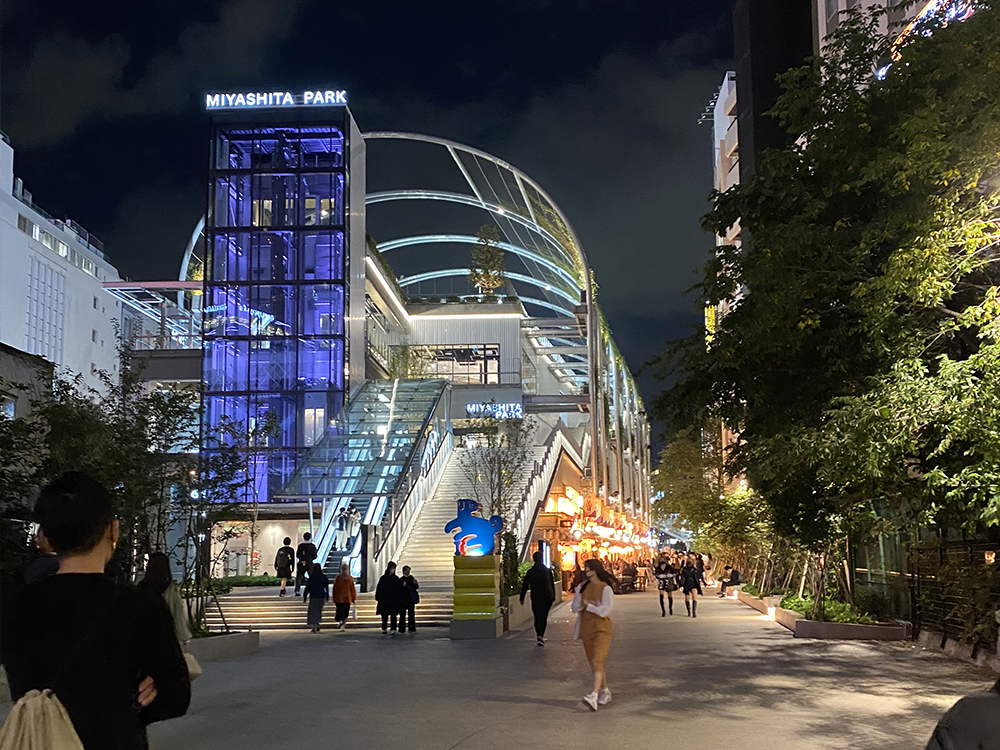
Entrance to Miyashita Park
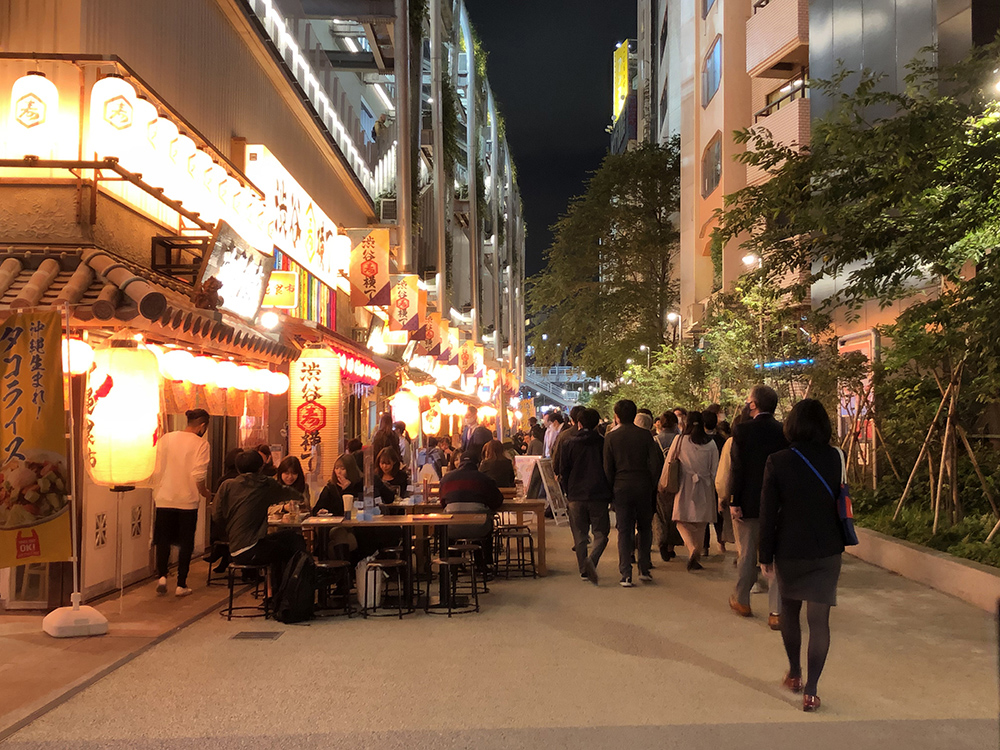
Shibuya Yokocho – vibrant red lighting full of energy
■Toyosu – A City Undergoing Various Development
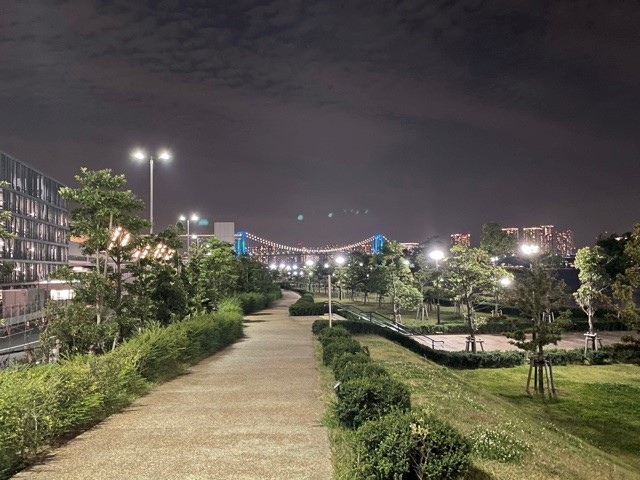
Toyosu Gururi Park – brightly lit jogging course
Toyosu is currently in the spotlight for the newly opened Toyosu Market, but our group focused on exploring Toyosu Gururi Park, which wraps around the waterfront. We began our walk by taking the Yurikamome Line to Shijō-mae Station. As it was nighttime, we couldn’t enter the Toyosu Market itself, but we observed the surrounding roads, all of which were well-maintained and equipped with low color temperature streetlights. However, we did notice some inconsistency, with fixtures of varying color temperatures scattered throughout the area.
Toyosu Gururi Park doubles as a jogging course, so the lighting was relatively bright to ensure nighttime safety. Still, it felt somewhat excessive, raising concerns that it might appear glaring when viewed from across the water—particularly from the direction of the former Olympic Village.
Toyosu Ohashi (Toyosu Bridge) sparked some mixed opinions. While it’s vibrantly lit in striking colors that certainly draw the eye, some felt it was a bit too bright. Overall, it left us with divided impressions.
Interestingly, even within the same jogging course, we found areas with brick walls that created a calm, subdued atmosphere. The contrast between sections made it enjoyable—perhaps that’s the appeal, being able to jog through different moods along the same path. Near LaLaport Toyosu, we also noted a bus stop with an unusually calm and elegant design, which left a very positive impression.
Though this walk focused solely on the area around Toyosu Gururi Park, and we expected it might lack variation, we were surprised to find subtle changes in atmosphere throughout. The most memorable feature was the lighting along the jogging path. Given the scale of development here, we strongly felt that the nighttime appearance from surrounding areas should also be carefully considered. (Shinichi Sakaguchi)
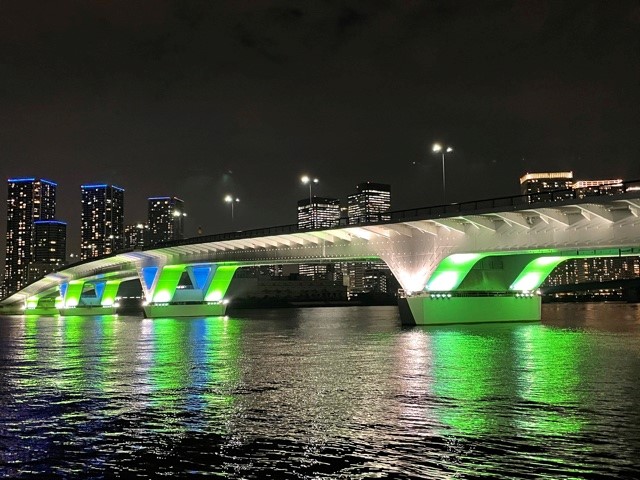
Opinions were divided regarding the colorful lighting on Toyosu Ohashi Bridge
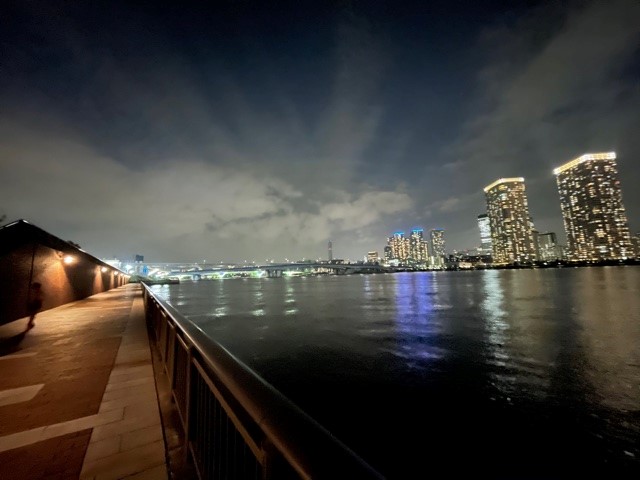
A jogging course with a calm and relaxing atmosphere
■Yanaka – A Beloved Old Shopping Street and Residential Area
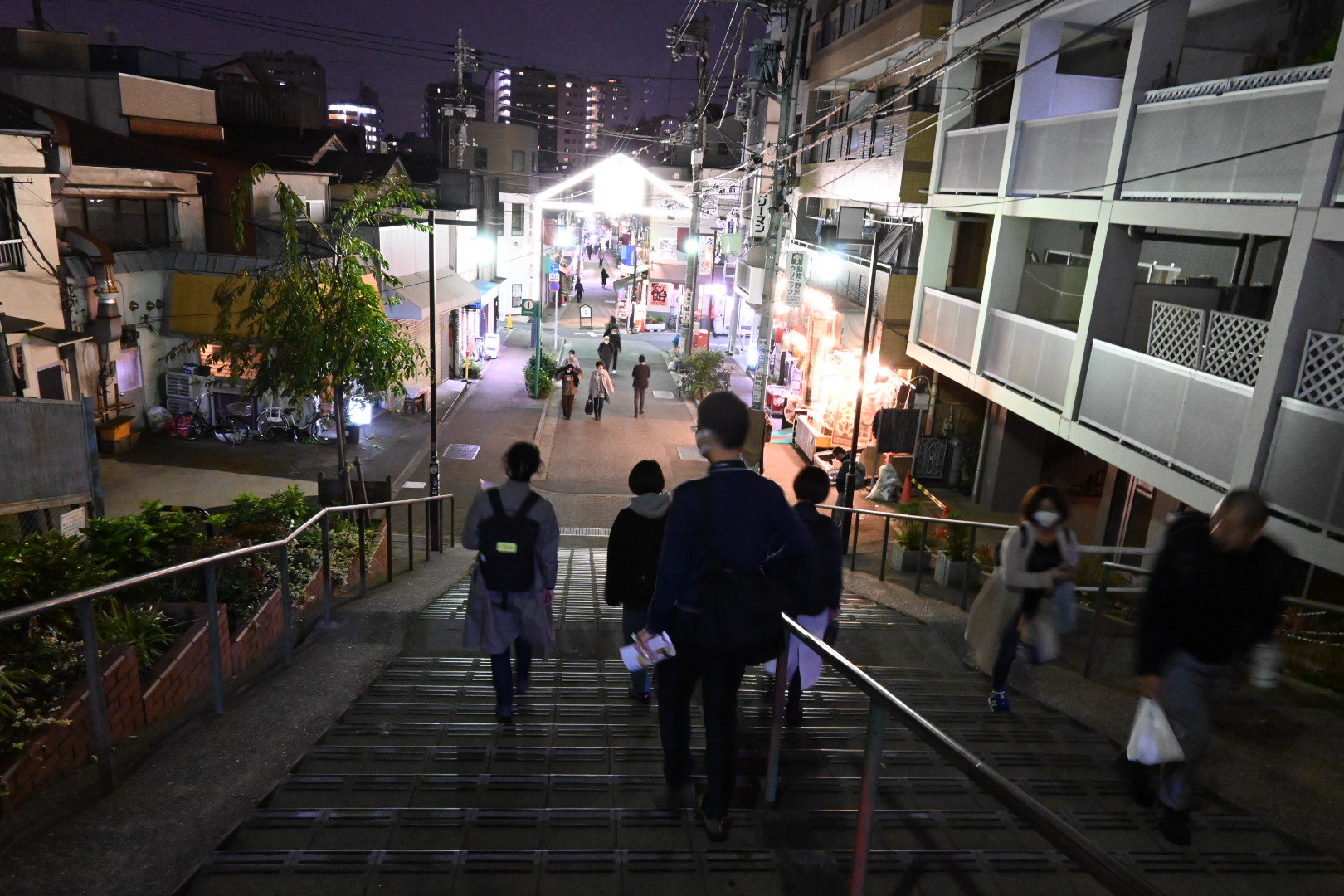
At the bottom of the Yuyake Dandan steps in Yanaka lies a lively shopping street
Our group focused our walk around Yanaka Ginza, exploring nearby streets such as Shinobazu-dori street, Hebi-michi-alley, Misaki-zaka-slope, and Onarizaka-slope under the theme “A Walk Through Shopping Streets and Dense Residential Areas.”
Throughout the residential zones and surrounding streets, we found several stylish shops unified by low color temperature lighting, creating a cozy atmosphere. However, as always, the harsh glare of standard “LED security lights” drew criticism from many, who labeled them as *villains*. Some areas were particularly problematic, with multiple fixtures installed at low heights, resulting in excessive brightness. In contrast, the older mercury vapor lamps surprisingly left a positive impression. Many participants felt that they didn’t produce an unpleasant glare, and their soft glow was generally more agreeable
Yanaka Ginza was a true visual chaos, filled with various store signs, wall-mounted bracket lights, and streetlights all competing for attention. However, despite the clutter, the store signage and wall-mounted bracket lights (the latter being a rare and interesting feature) were mostly unified with low color temperature fixtures. If the visual focus could be directed toward these warmer elements, the area has the potential to become a much more calm and pleasant space. This highlighted the importance of holistic coordination, and we’re hopeful for future improvements.
This area was previously surveyed in 2014 by LPA staff, and upon comparing with those earlier reports, we noticed little has changed—apart from a slight increase in LED fixtures.
It had been a while since our last night walk, and this experience reaffirmed the value of walking the streets in person and feeling the atmosphere firsthand. More than anything, it was simply a lot of fun. The smaller group allowed for more in-depth discussion than usual, making it a highly fulfilling outing. With the world still clouded by grim news, we sincerely hope for the end of the pandemic so we can once again enjoy nighttime strolls with lighter hearts. (Satoshi Tamura)
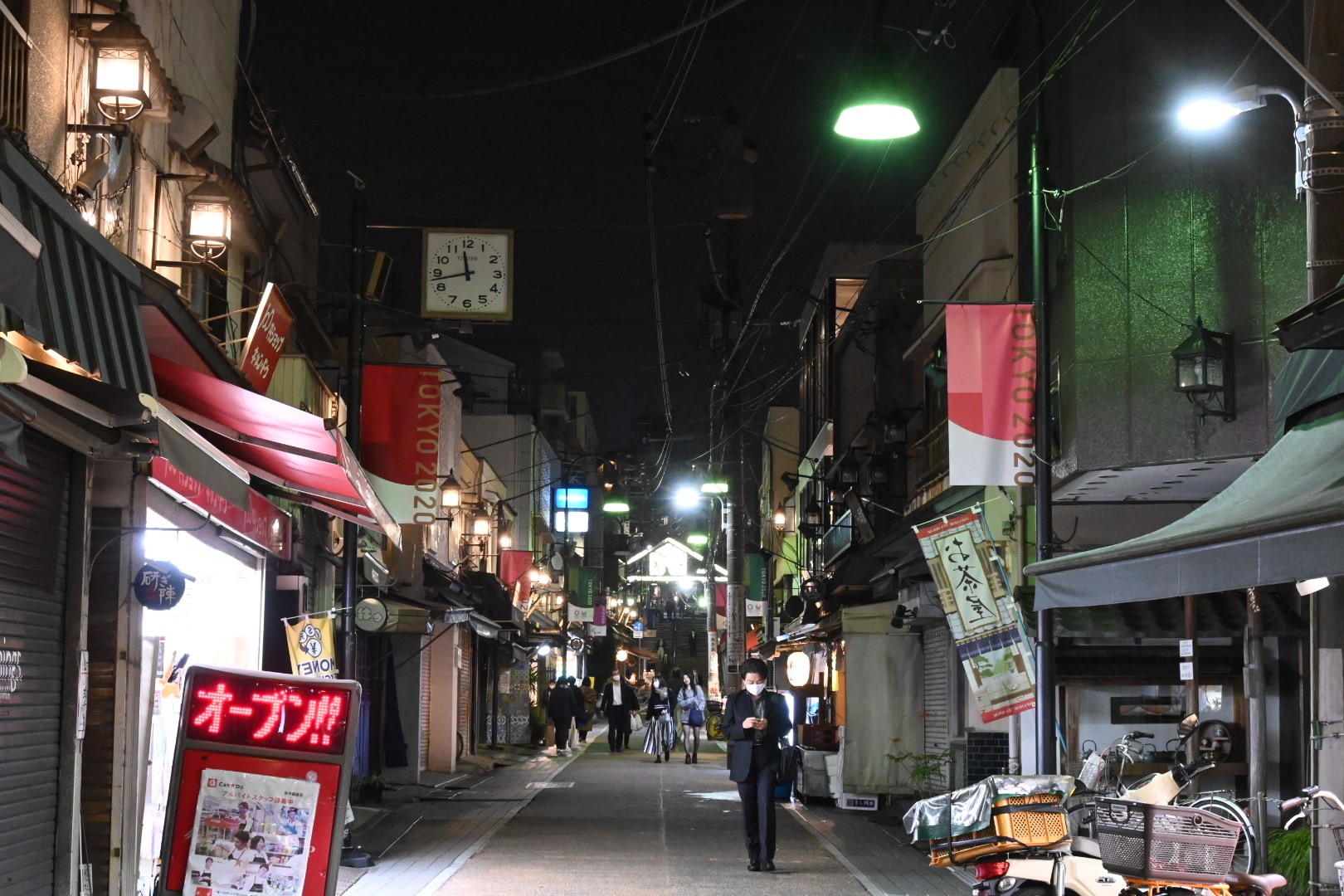
A chaotic cluster of lights: Yanaka Ginza
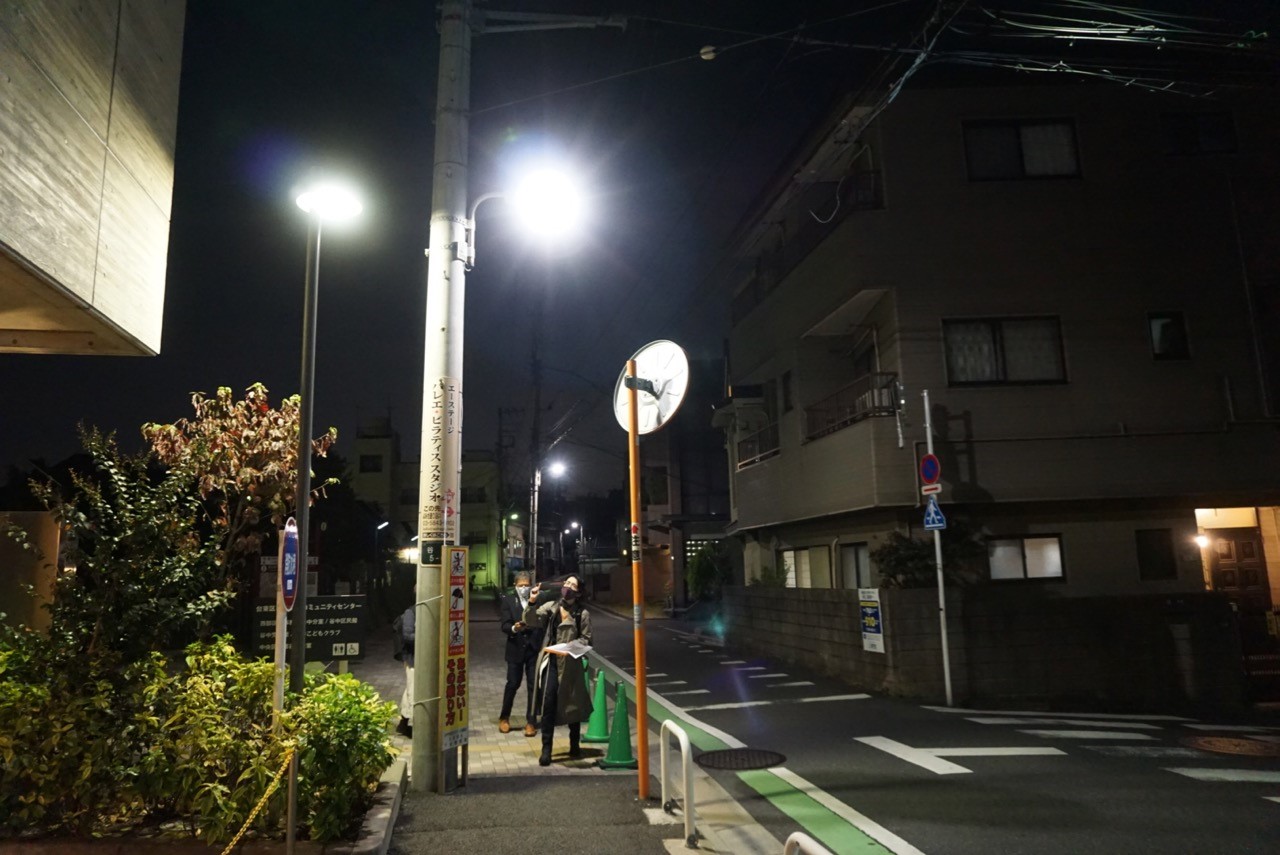
Yanaka – The clear standout villain: the LED security lights
■Sugamo – Around Somei Cemetery: What Cemetery Lighting Is Like?
During the COVID-19 pandemic, we planned small-scale night walk surveys with the theme of cemeteries. We wondered, what kind of lighting is present in cemeteries at night? We chose Somei Cemetery in Sugamo, Tokyo. As a metropolitan cemetery, it is located near bustling areas such as JR Sugamo Station and the Togenuki Jizo shopping street, allowing us to observe the contrast and coexistence between lively commercial zones and the cemetery’s quietness. As a side note, Somei Cemetery is home to many old cherry trees, and the famous “Somei Yoshino” cherry blossom variety originated here.
Starting from Sugamo Station, after a 10-minute walk through the shopping street, turning right off the main road leads to the cemetery entrance. The cemetery covers about 67,911 square meters and is the resting place of approximately 30,000 individuals. We entered the cemetery around 6:30 PM and found the atmosphere was not eerie as one might imagine. Inside, there are pedestrian paths and roads accessible to vehicles, all well-lit by LED streetlights.
The main paths maintain illuminance levels between 4 to 6 lux on the ground, and solar-battery-powered pole lights placed roughly every 200 meters provide direct illumination of about 50 lux beneath them.
Because the cemetery lies on the expansive flatlands of Tokyo, distant cityscapes including highrise areas like Ikebukuro, Shinjuku, and Ueno are visible, contributing to the overall sense of brightness in the space.
The LEDs used have a high color temperature ranging from 5000 to 6500 K. Had the illuminance been only 1 to 2 lux at these color temperatures, the space would have felt truly eerie. This experience made us realize that even within Tokyo’s urban area, there exist spatial atmospheres unlike any other. (Takashi Amemiya)
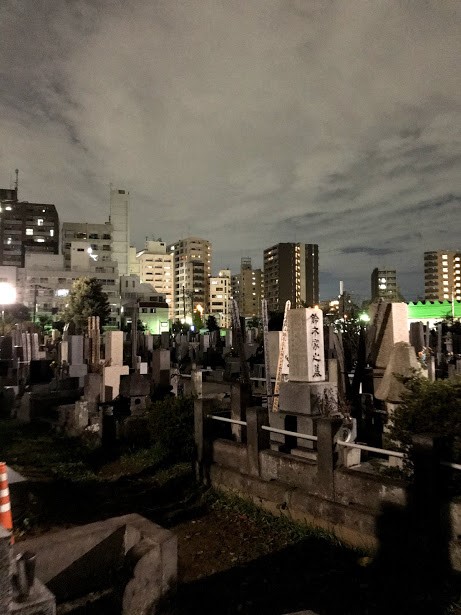
A wide, open space where the distant lights of buildings create a sense of brightness for the cemetery
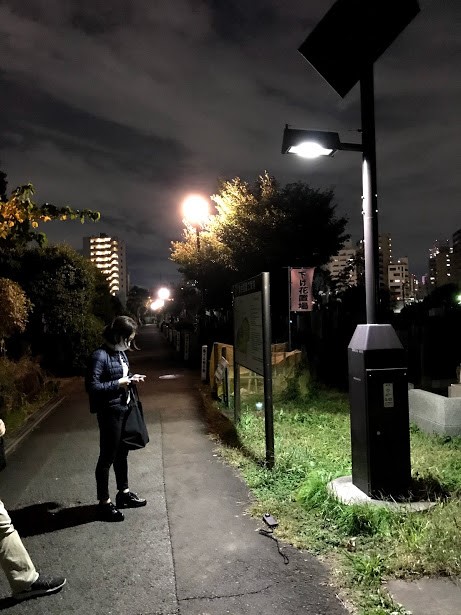
Some solar battery-powered pole lights at Somei Cemetery provide ample illumination
■Nagoya/ Sakae — Observation of Flashy Streetlights
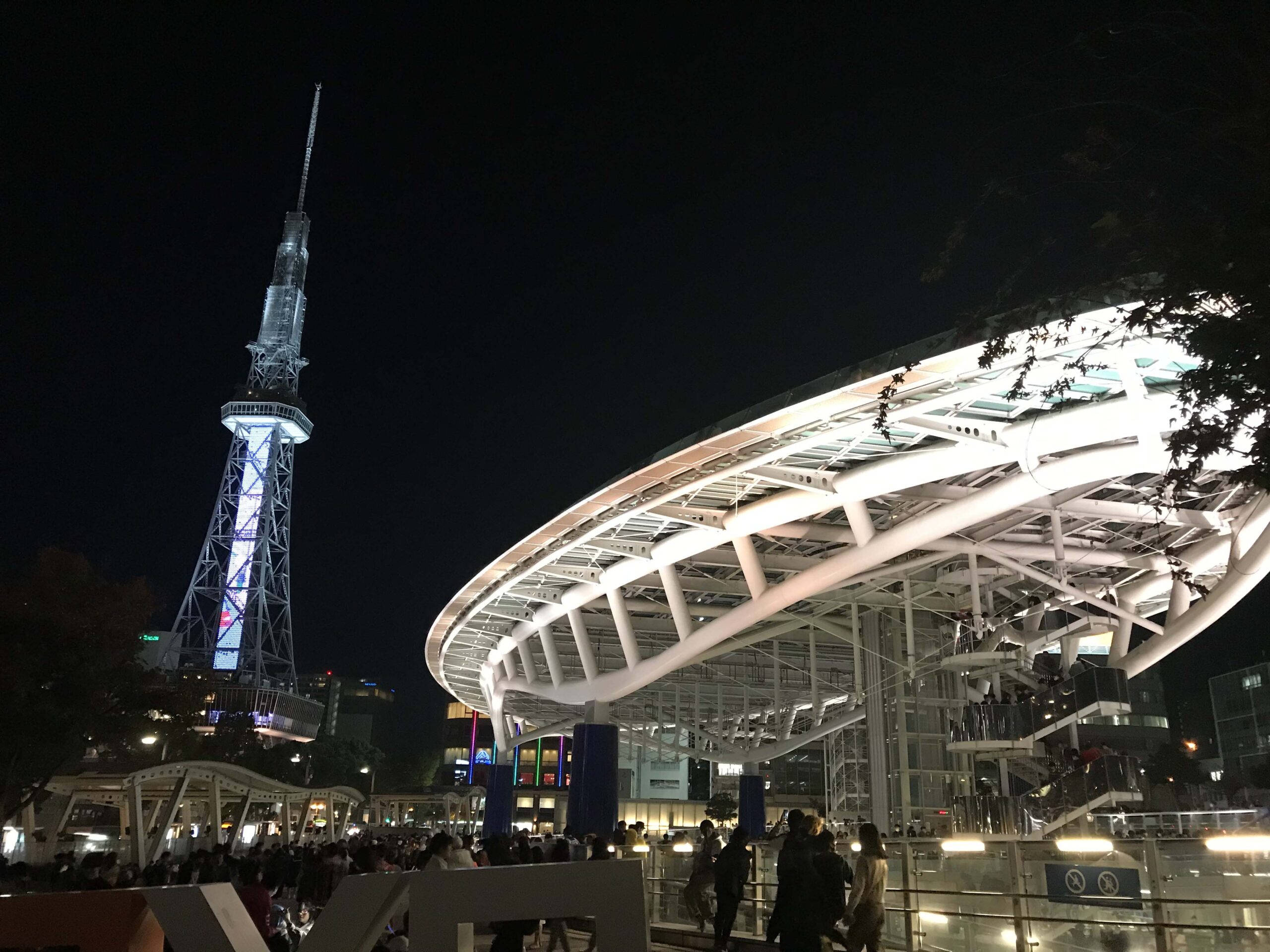
Nagoya’s TV Tower and Oasis 21 remain iconic landmarks of the city even at night
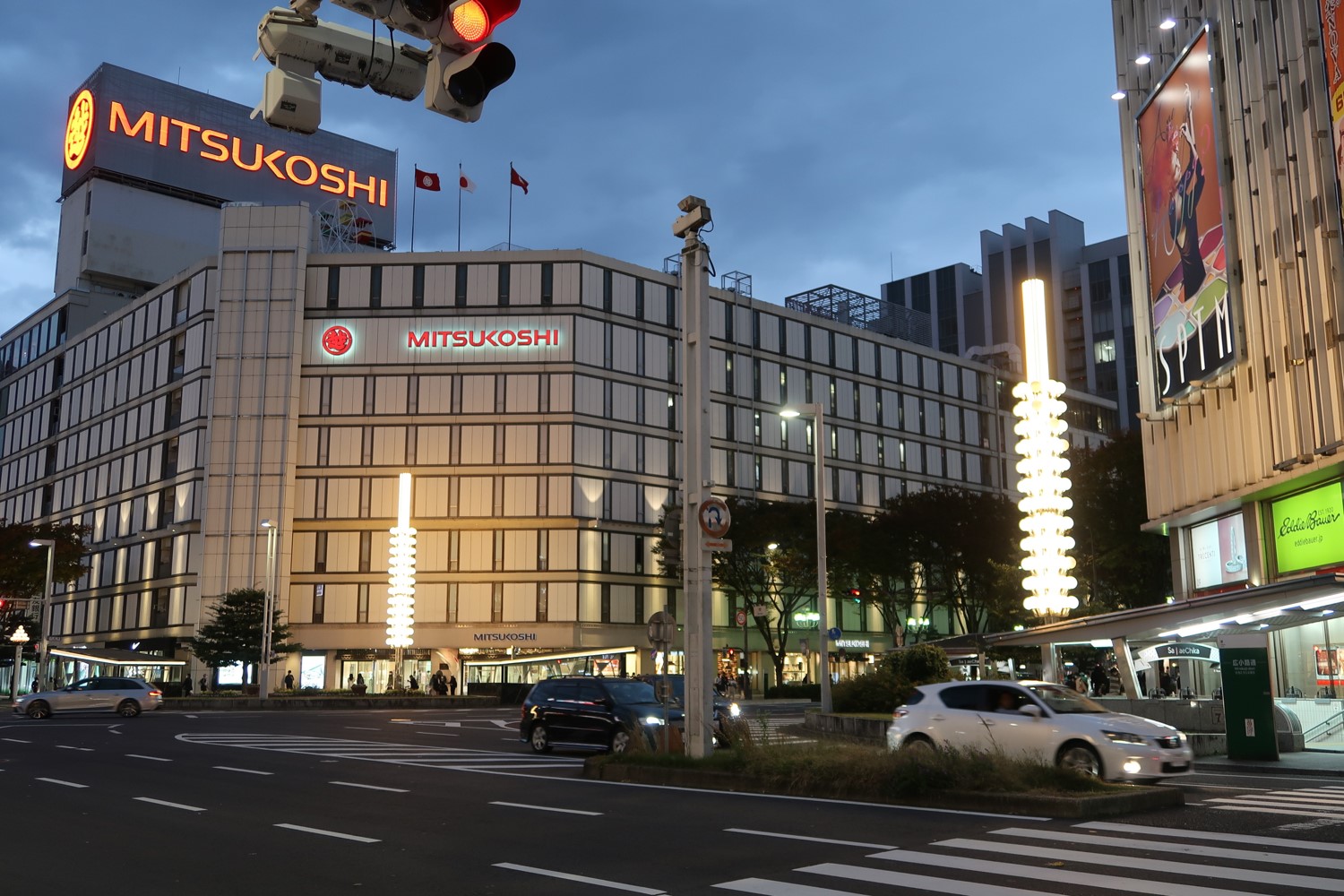 Hero: The unique streetlights at Sakae Intersection
Hero: The unique streetlights at Sakae IntersectionOn November 3rd, under clear skies, the Nagoya team’s night walk survey was conducted by three people: Professor Honma from Shiga, Ms. Kotani from Osaka, and Suzuki, who lives in Nagoya. We focused on recommended spots shared by Ms. Uomori, who lives in Kyoto and gave us discoveries from his business trips to Nagoya, and Professor Honma, a former Nagoya resident. For Ms. Kotani, it was her first visit to Nagoya. Although I have lived in Nagoya for five years, I had only seen Sakae as a shopping district, so this was a great opportunity to see the city from a fresh perspective. We met for the first time at the basement floor of Sakae Mitsukoshi, but somehow it felt like we had known each other for a long time, and the walk started with a friendly atmosphere.
We began our walk by observing the uniquely shaped streetlights at the Mitsukoshi intersection. It was a perfect opening scene for the walk—vibrant and photogenic. We took photos and exchanged thoughts on the lighting design. As we walked from Princess Street toward Hisaya Odori Park, we discussed the color of the angled streetlights and how it resonated with the atmosphere of the neighborhood. We also paid attention to the ambient light spilling from surrounding buildings and how it shaped the feel of the streetscape. Next, we visited Oasis 21 and the TV Tower—two iconic landmarks that represent the Sakae area. A comment was made that it would be fascinating if the LED lighting on these two structures were somehow synchronized to respond to each other.
Afterward, we left Sakae and headed toward Fushimi Station. Though the forecast had promised clear skies all day, we were caught in an unexpected drizzle. As we walked briskly through the rain, we observed how the blue LED lighting cast an eerie tone over the city. It was something we hadn’t noticed in daily life, but through focused observation, we realized that the streetlights in the area came in various shapes and designs. It became clear that there are still many places in Nagoya worth exploring through the lens of the Lighting Detectives. (Yuka Suzuki)
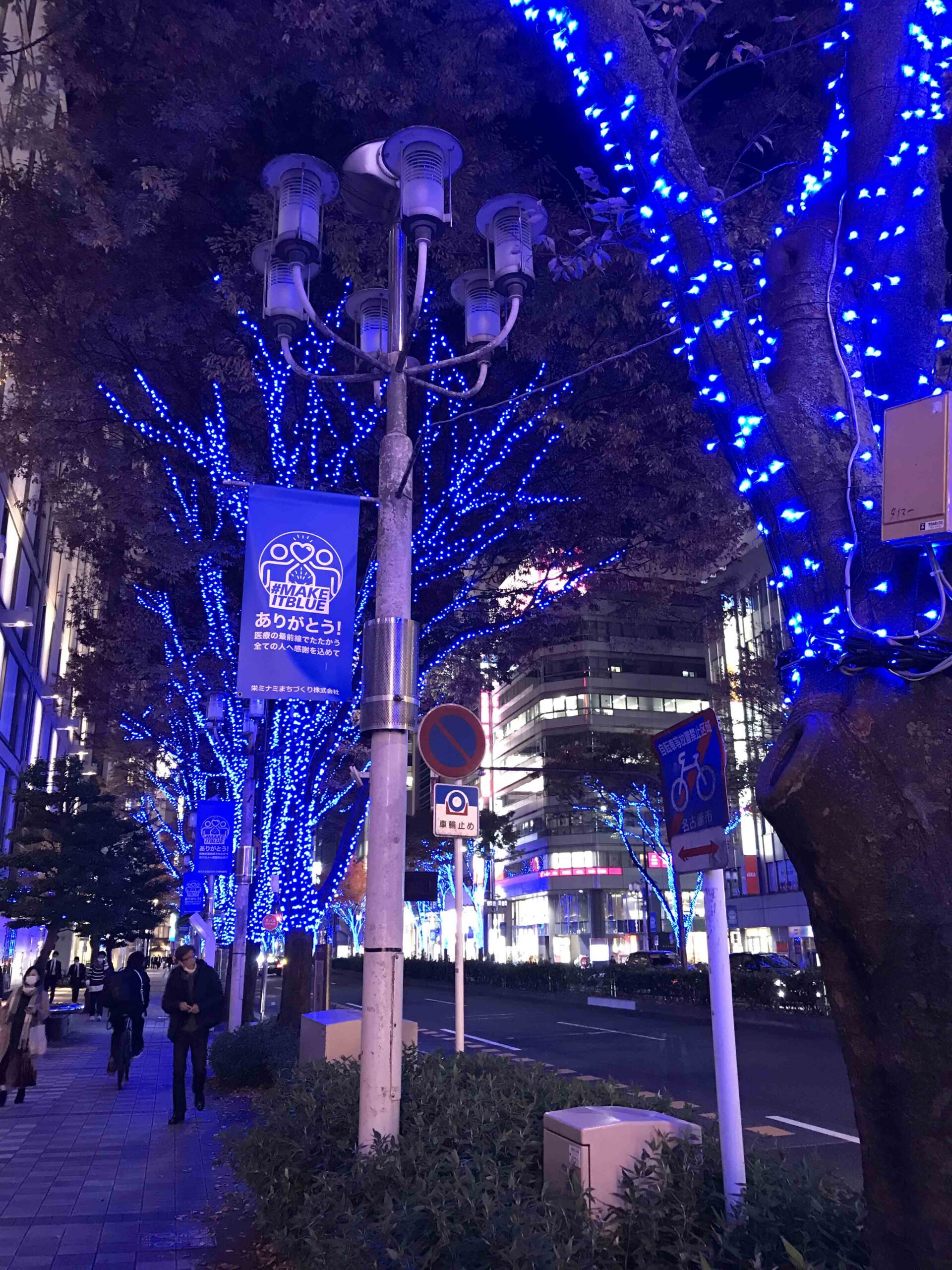
Villain: The LED illuminations with strong blue tones
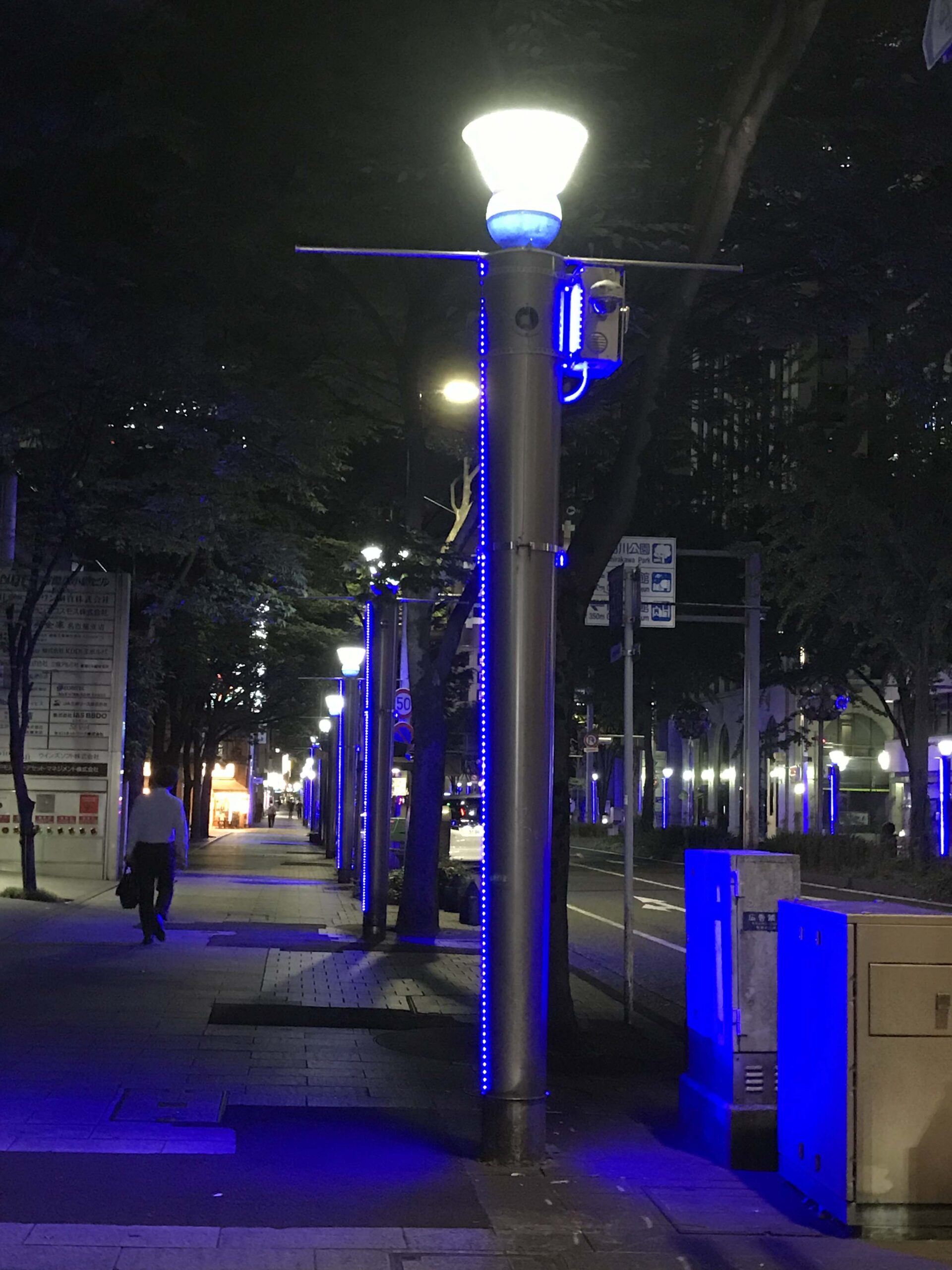
Villain: LED illuminations with intense blue hues 2
■Midosuji Illumination in Osaka — Good or Bad?
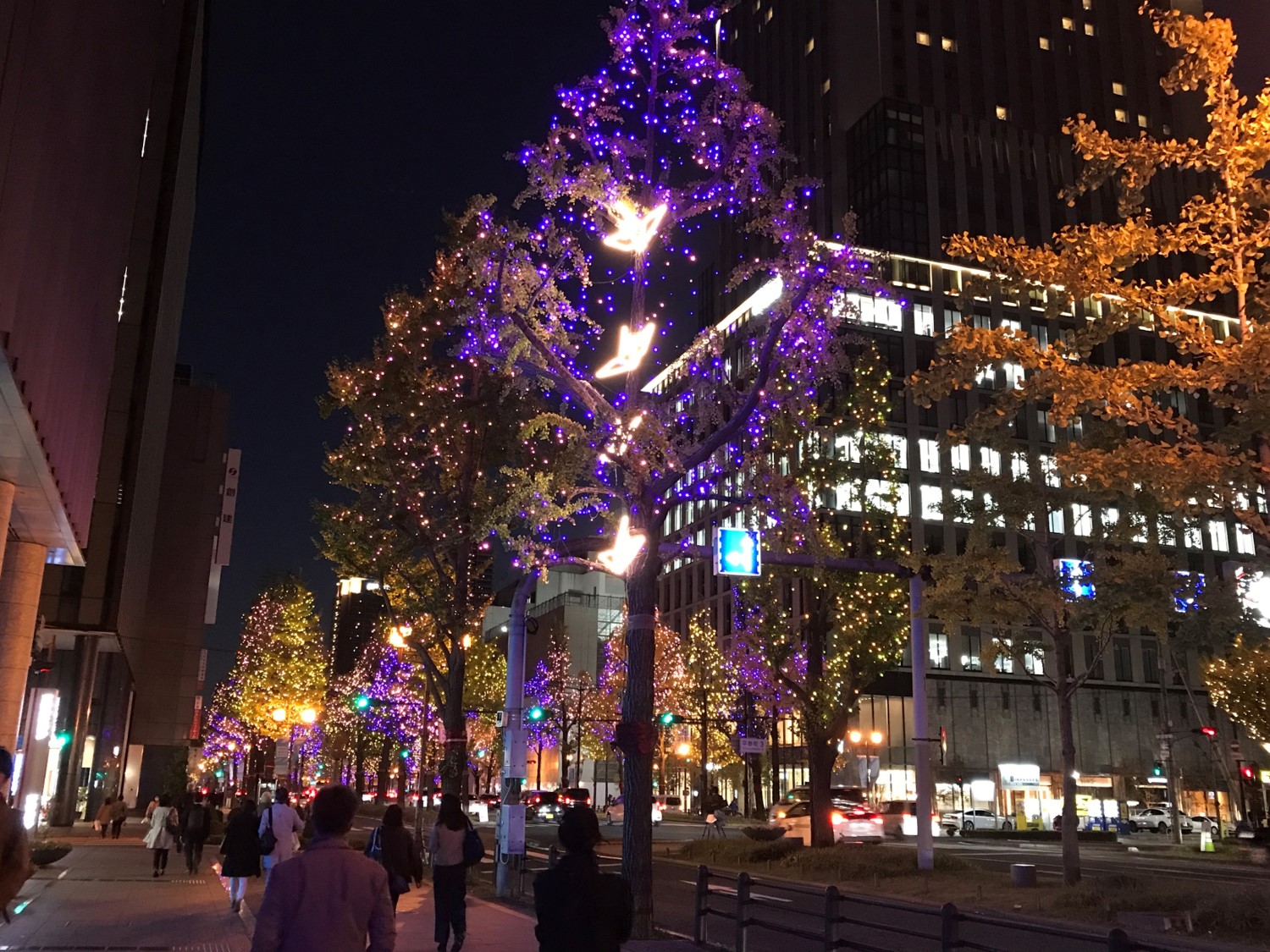 Midosuji: A Magical, Dreamlike World
Midosuji: A Magical, Dreamlike World
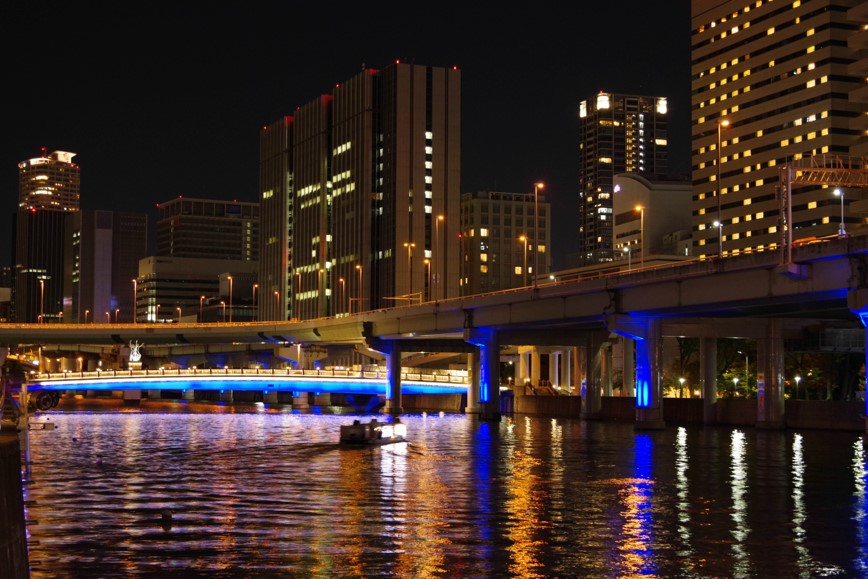 Midosuji: Lighting Beneath the Expressway
Midosuji: Lighting Beneath the Expressway
We conducted a night walk survey along the 5-kilometer stretch of illuminated Midosuji Boulevard, from Umeda to Namba. At the outset, I felt a bit disappointed by the colorful lighting—personally, I’ve always believed that the charm of illuminations lies in the warm glow of incandescent-colored lights. So I began the walk with mixed feelings.
Almost immediately, we encountered a strikingly lit tree at a major intersection. It was adorned with LED lights of various sizes in warm tones, and the differing brightness levels enhanced its brilliance, creating a captivating entrance to the illuminated boulevard. Lights were focused only on the leaves, making each one shimmer individually and creating a floating, dreamlike atmosphere. As the lighting gradually transitioned into colored lights, surprisingly, it didn’t feel jarring or out of place. Instead of the cold artificiality I had expected, the colors evoked a sense of comfort and enchantment—perhaps because in today’s fast-paced society, this sort of fantasy and healing ambiance is precisely what people seek. Not just the trees, but also the buildings and elevated highways were lit up, transforming everyday scenes into something extraordinary. The entire cityscape was wrapped in light, and the experience left a deep impression—this was a magical, immersive urban nightscape that felt both festive and rejuvenating.
However, the regular streetlights remained on throughout the event, disrupting the otherwise magical, dreamlike atmosphere—and were unanimously deemed villains. While the retro design of the streetlights themselves was not necessarily out of place among the illuminations, the color temperature and brightness overpowered the subtle charm of the decorative lighting. As a result, we all agreed that the standard streetlights should have been turned off during the illumination hours.
In the end, we felt that while the distance of the 5km stretch might be ideal for enjoying the lights from a car, it felt a bit too long on foot. If the boulevard were divided into smaller zones, with different lighting effects repeated at regular intervals, the experience might be more engaging and enjoyable for pedestrians. (Amane Kotani)
Although we were initially concerned about whether the small-group format would generate the same excitement as past surveys, it turned out that the intimate setting actually encouraged deeper discussion. Everyone was able to express their thoughts without hesitation, and it felt like each team built a stronger sense of camaraderie. I hope we can continue embracing this kind of activity that suits the current times. (Noriko Higashi)
Round Table Discussion Vol. 65 @ ZOOM
Small Group Night Walk Review
2020.11.28 東悟子
An online review session was held to reflect on the “Small Group” night walk surveys conducted across seven locations in October and November. As members shared their observations and experiences, each report sparked curiosity and inspiration—many found themselves wanting to explore the places others had visited next.
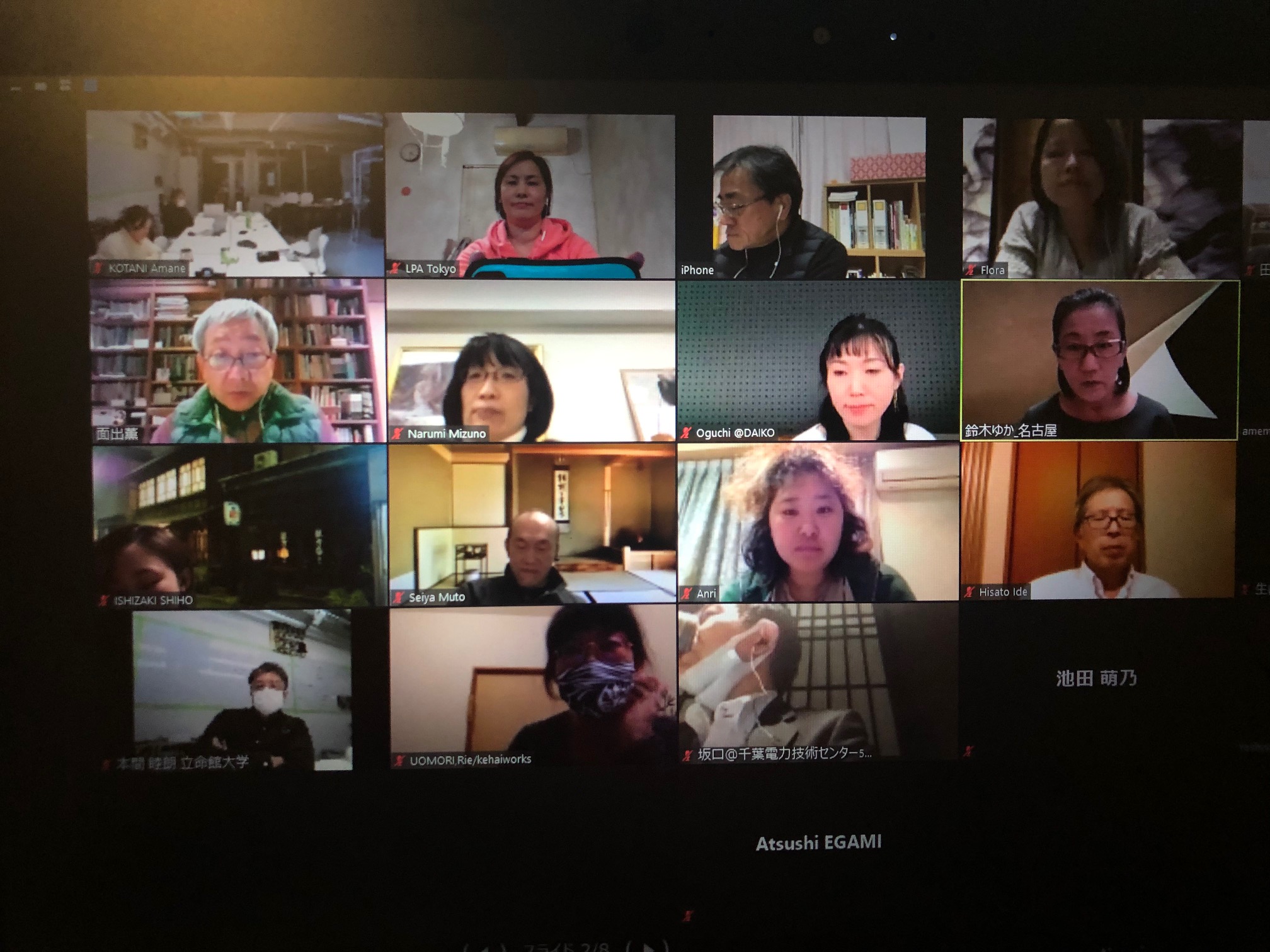 Participants joined from a variety of locations — their homes, workplaces, izakaya(Japanese style pubs), and even schools
Participants joined from a variety of locations — their homes, workplaces, izakaya(Japanese style pubs), and even schools
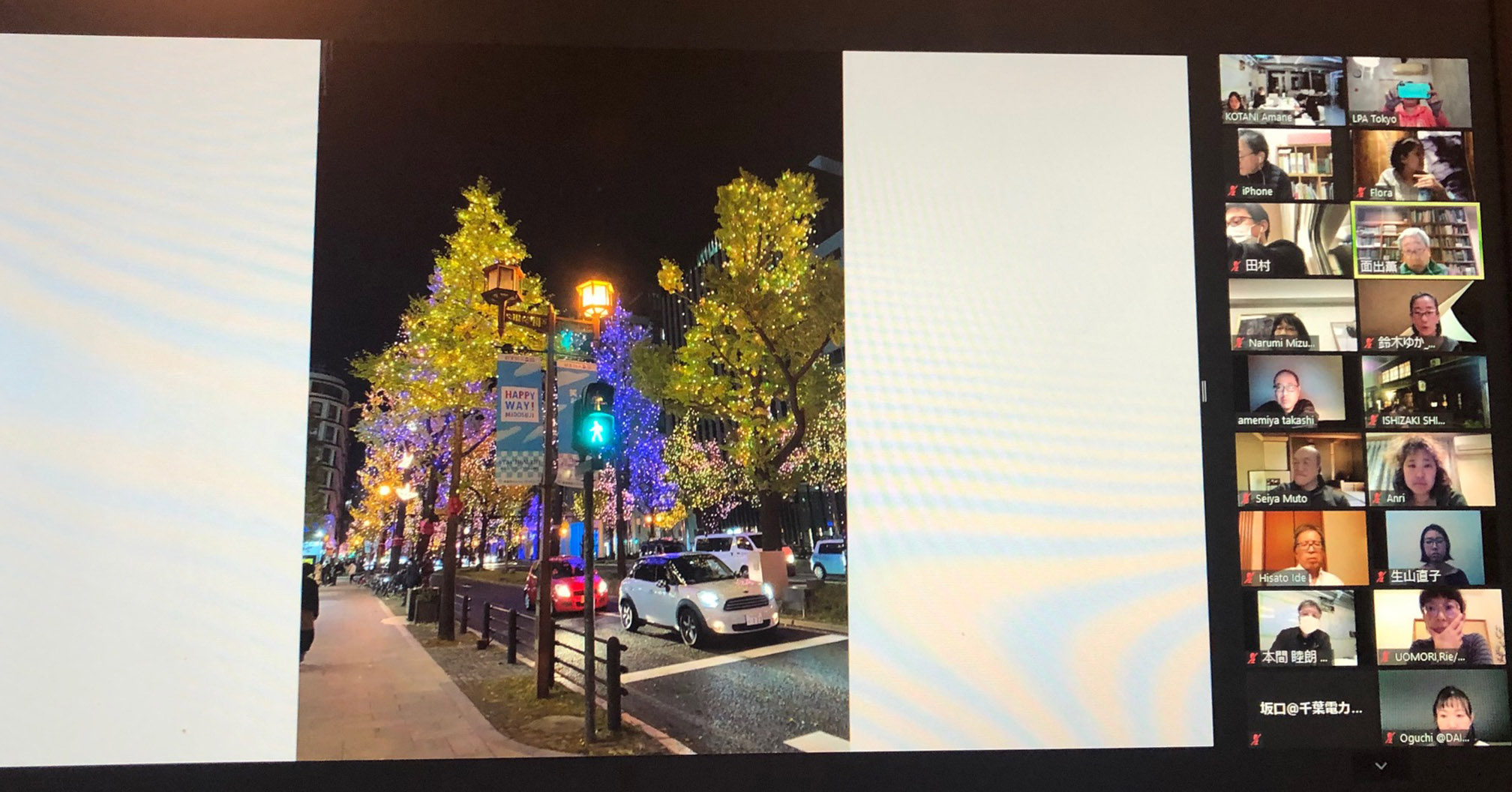 Each group leader gave a report on their night walk survey findings
Each group leader gave a report on their night walk survey findings
We held our fourth online salon of the year, focusing on a review of the night walk surveys conducted in small groups during October and November. Each area leader reported on their respective night walk survey. Typically, we divide into three to four groups to explore the same area and then present our findings. However, this time, the night walk surveys were conducted in completely different locations—including Nagoya, the Midosuji Illumination in Osaka, the Shibuya public restroom tour & Miyashita Park, Toyosu, Yanaka, Azabu-Juban, and Somei Cemetery & Sugamo. As a result, the reports were rich in variety, and the 90 minutes flew by.
In the report from Nagoya, which focused on streetlights, large and flamboyantly designed streetlights were introduced and praised as “heroes” for contributing to the vibrant, energetic atmosphere characteristic of the city. On the other hand, LED illuminations that cast an overwhelmingly blue hue over the surroundings were labeled as “villains.” The team in charge of the Midosuji Illumination in Osaka noted that while the use of various colors made the illuminations feel festive, they were not well received by some members who preferred warm, subdued lighting. Still, the space was described as dreamlike, and it was agreed that the overall mood of the town was successfully created. One issue raised was how to better integrate the existing streetlights with the illumination.
During the Shibuya restroom night walk survey, participants reported on newly designed public restrooms created by architects and designers. Each facility had a distinct concept and personality, and while opinions varied based on personal taste, there was unanimous agreement on the importance of increasing the number of clean and welcoming public restrooms. However, some raised the point that it may be necessary to reconsider the overall lighting environment of the parks in which these restrooms are located—not just the toilets themselves.
From the Toyosu team, it was noted that the jogging paths were lit with more than sufficient brightness, perhaps even excessively so. There was concern that the lighting might appear glaring when viewed from across the water. One especially memorable nightscape highlighted in the report was the lights from the Toyosu high-rise apartments. Their reflections on the water created a beautiful and striking night view.
The Yanaka team reported that rather than the shopping street itself, it was individual shops that were making the most effort with their lighting. The street as a whole showed a coexistence of both unity and inconsistency. As expected, security lights in the residential areas were labeled as villains.
A particularly chaotic intersection was highlighted, where an accumulation of added streetlights and security lights had created a sort of lighting traffic jam.
The Azabu-Juban team introduced an area where old and new coexist, creating a multicultural and diverse neighborhood. Various types of lighting were observed—some atmospheric, some stimulating, and others simply indifferent. The team concluded that with some thoughtful organization and a lighting plan that expresses the unique identity of the area as a whole, Azabu could become an even more charming nightscape.
The Somei Cemetery team did not frame their observations in terms of heroes or villains, but instead reported on the lighting environment of the cemetery, which also serves as a pedestrian thoroughfare. Situated on elevated ground with a good view, the cemetery felt nothing like the eerie or spooky place one might expect. In fact, it was brighter than anticipated, with more foot traffic than imagined, creating no sense of darkness or fear.
After visiting the cemetery, the team surveyed Sugamo. Though it is technically a shopping street, there were few dining options, and most shops were closed at night. As a result, the team felt that the lively atmosphere they had hoped for, contrasting with the somber cemetery, was unexpectedly absent.
Because the salon was held online, participants could join from home, allowing for night walk surveys in various parts of Japan and the sharing of diverse findings. This format seems to have opened up new possibilities for how the Lighting Detectives can carry out their activities moving forward. Even once large gatherings become feasible again, incorporating online elements and pursuing a hybrid model may well be the ideal “new normal.” We look forward to bringing you more engaging activities in the future! (Noriko Higashi)
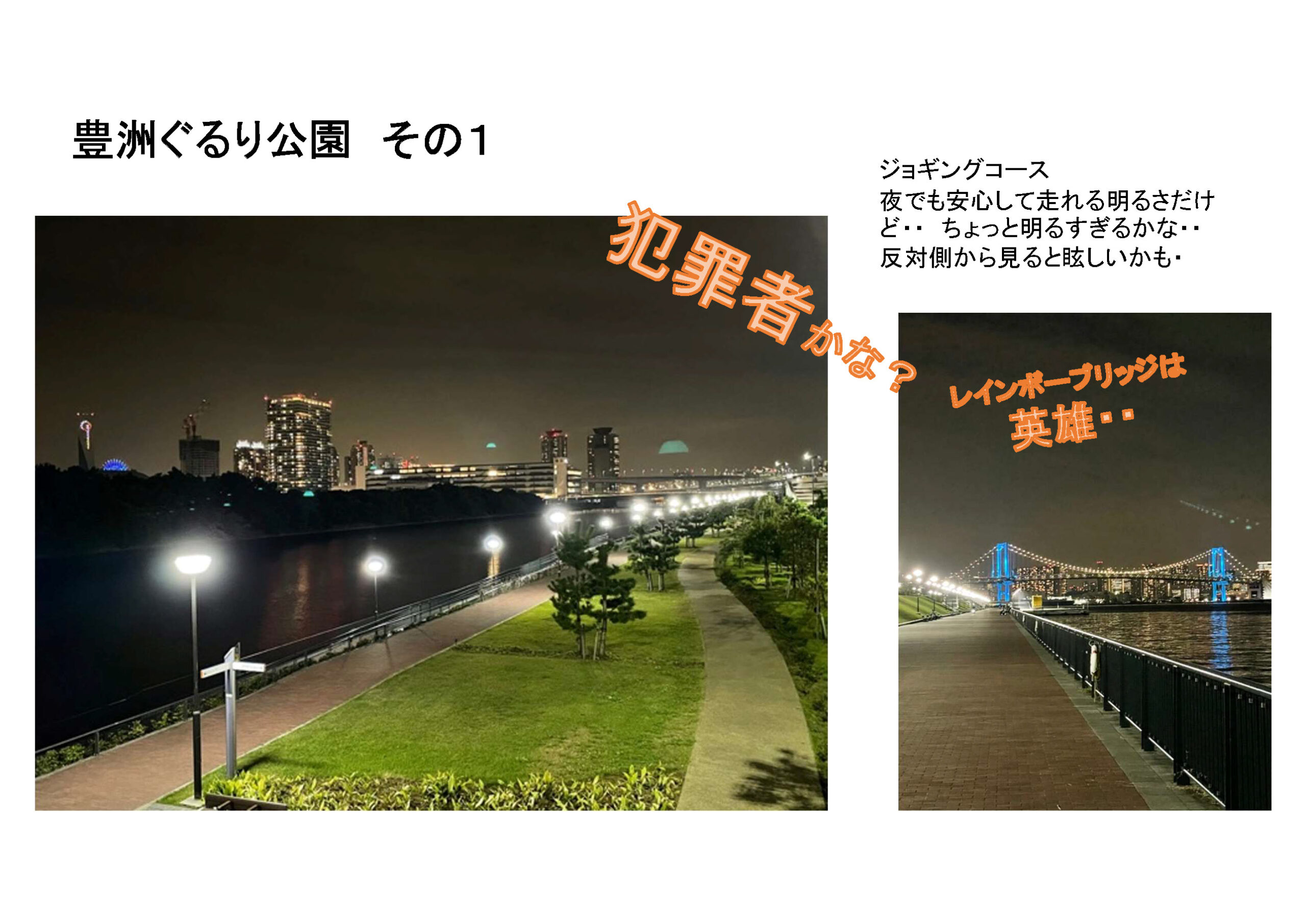
Presentation slides from the Toyosu team
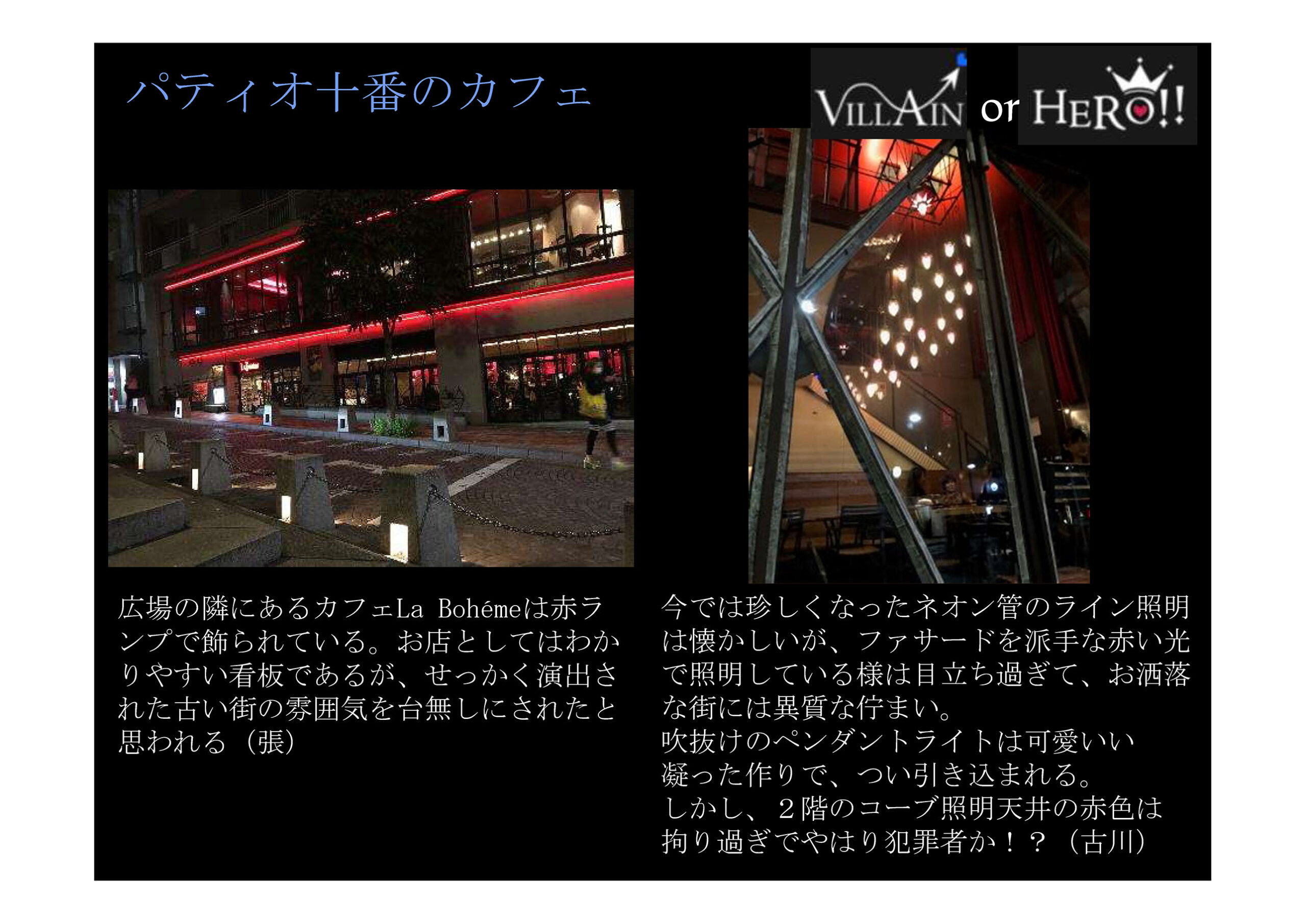
Presentation slides from the Azabu team
Light-Up Workshop in Akiu Onsen
2020.11.18 Noriko Higashi
A light-up event titled “Akiu Lumina 2020” was held from November 14th to 23rd in Akiu Onsen, located in Sendai City, Miyagi Prefecture. As part of the event, the Lighting Detectives conducted a light-up workshop.
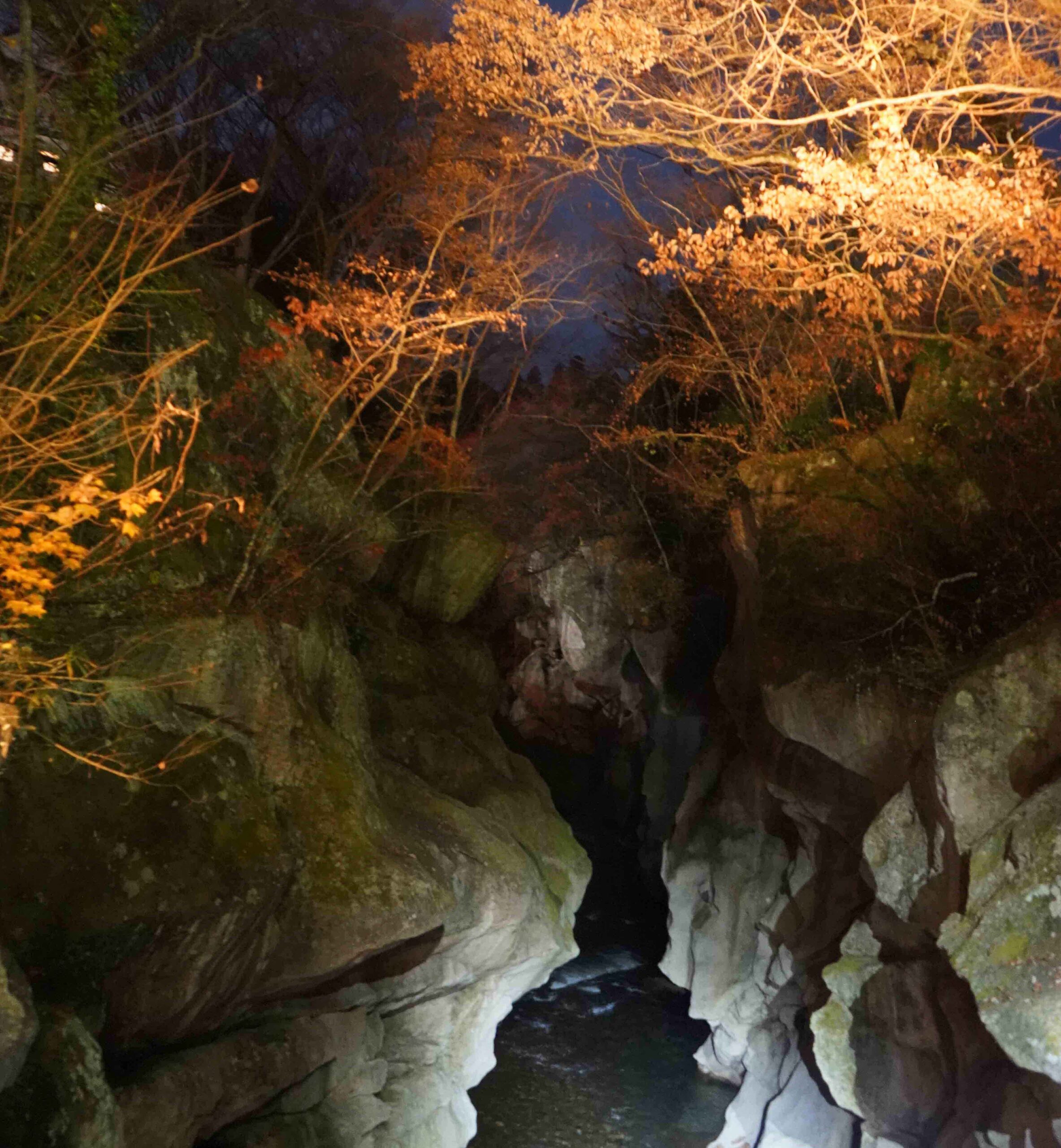
Lighting up Rairaikyo Gorge — the dark, hidden ravine revealed itself from the shadows
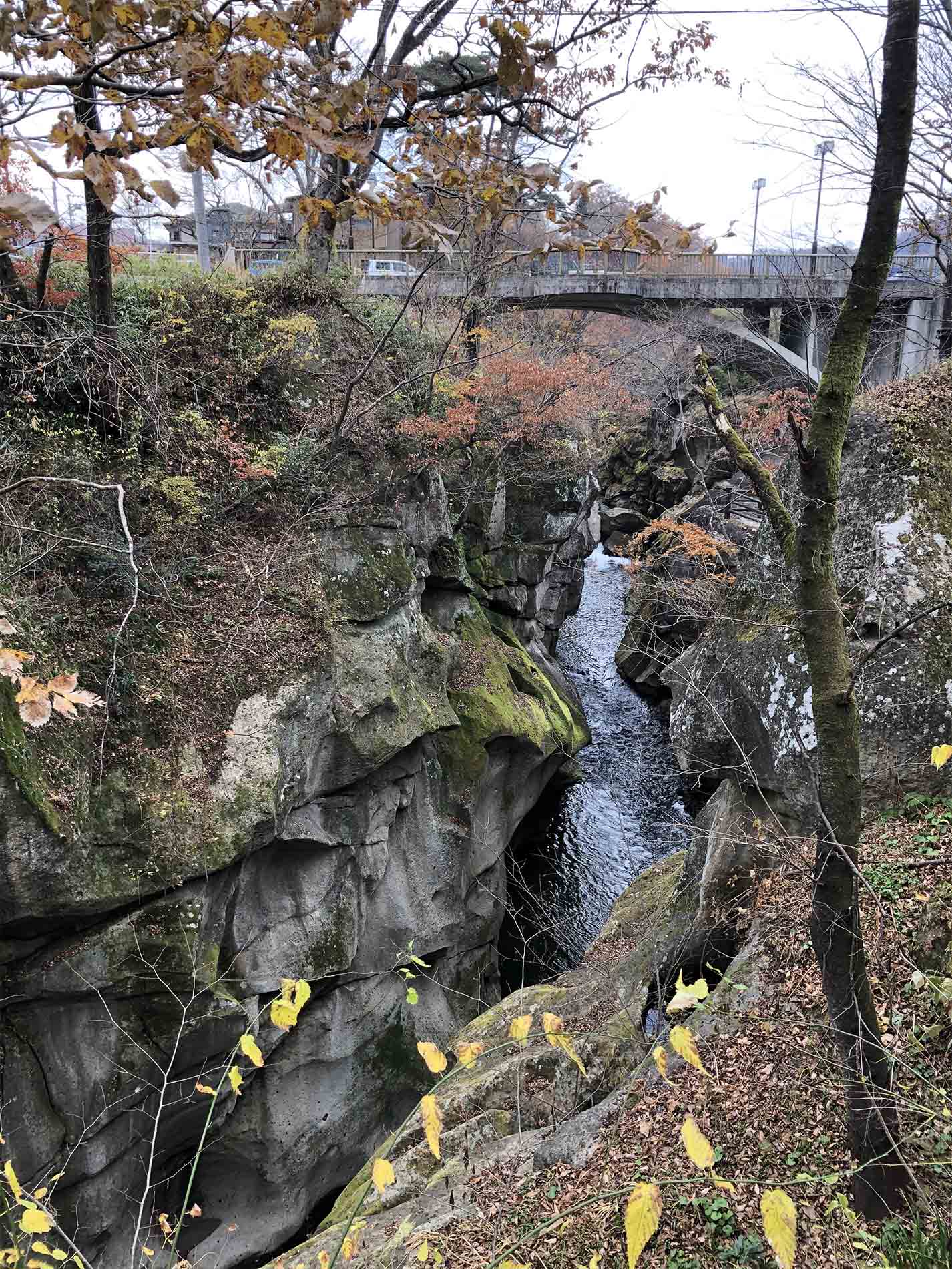 Rairaikyo Gorge during the day — an awe-inspiring sight of massive rocks
Rairaikyo Gorge during the day — an awe-inspiring sight of massive rocks
As part of the annual Akiu Lumina light-up event held each year during this season at Akiu Onsen, we conducted a lighting workshop.
Akiu was once home to a quarry, and traces of this history remain in the form of massive boulders found throughout the scenic Rairai Gorge. During the day, we visited the gorge for a preliminary site check. The sight of enormous rocks lined up within the canyon was truly overwhelming. A walking path runs along the gorge, where maple trees planted alongside were showing vivid shades of red and yellow. With the colorful autumn leaves, the gorge itself, bridges, and nearby inns all packed into a compact area, the site offered an ideal setting for a light-up workshop.
Around 30 participants—including local artists, inn staff, and shop owners—gathered to kick off the workshop. After an introduction to the Lighting Detectives and a brief lecture on the importance of nighttime scenery in urban environments, we headed straight to the gorge armed with flashlights and color filters.
From atop a bridge known as “Megane-bashi” (Spectacles Bridge), we began illuminating the rocks below. As the light swept across, the water and gorge—previously shrouded in darkness—suddenly emerged in view. Participants were surprised at how the angle of the flashlight dramatically changed the appearance of the water. Moving closer to the riverside, they used color filters to light up the rocks. Another surprising discovery was that some rocks reflected the color exactly as filtered, while others did not—an unexpected and fascinating result.
We illuminated the rocks with red, blue, and green light, then shared impressions of how each color transformed the scene. This sparked a discussion about which angles and positions created the most effective lighting. Participants didn’t stop at the rocks—maple trees in their autumn colors and the walking paths were also lit up and photographed.
There were also comments suggesting areas for improvement. Some noted that the hotel’s maple tree lighting was too glaring for pedestrians, while others pointed out that the walking paths were too dark. These observations highlighted the importance of balancing aesthetics with safety and comfort in public lighting.
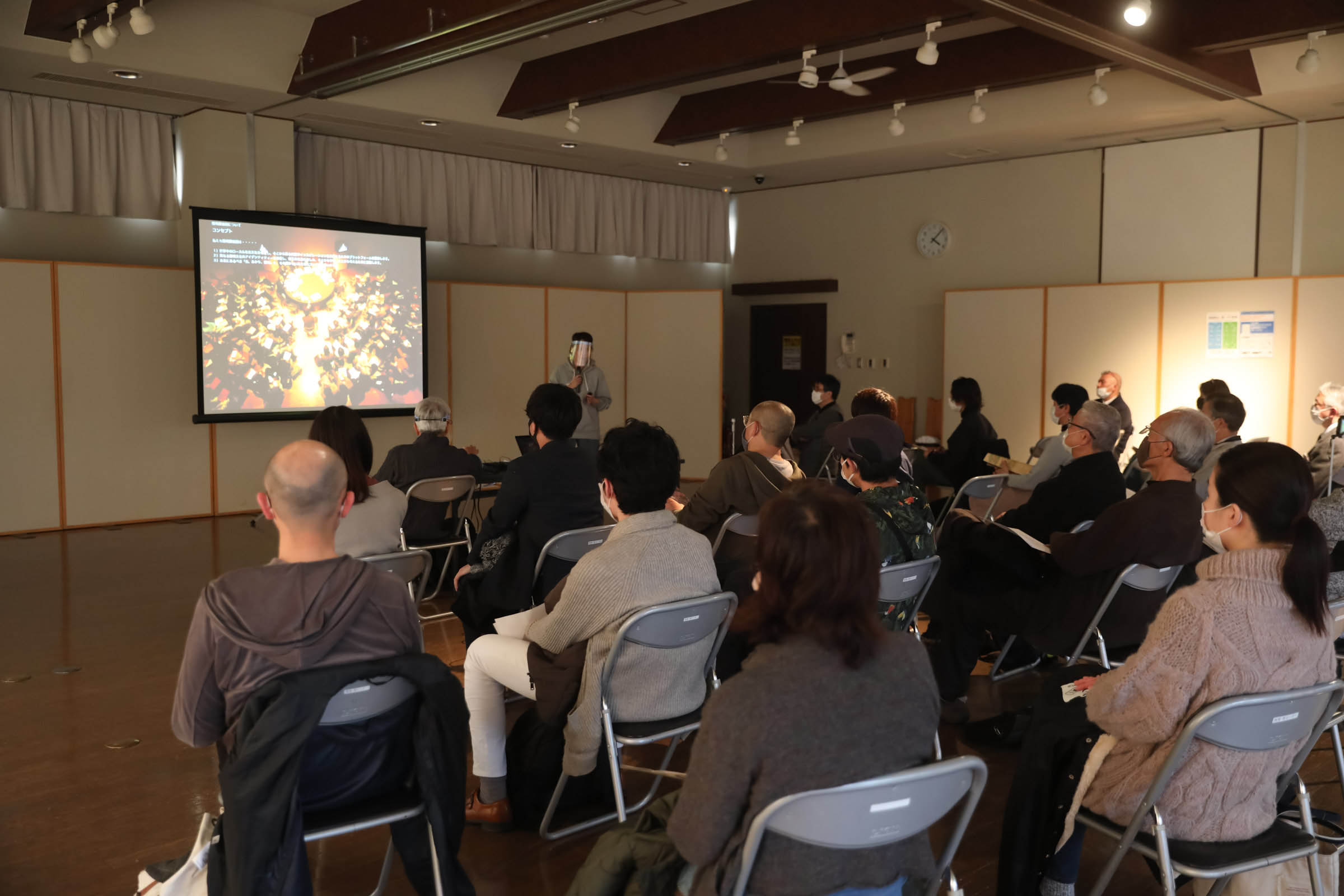
An introduction to the Lighting Detectives and a lecture on the importance of nightscapes
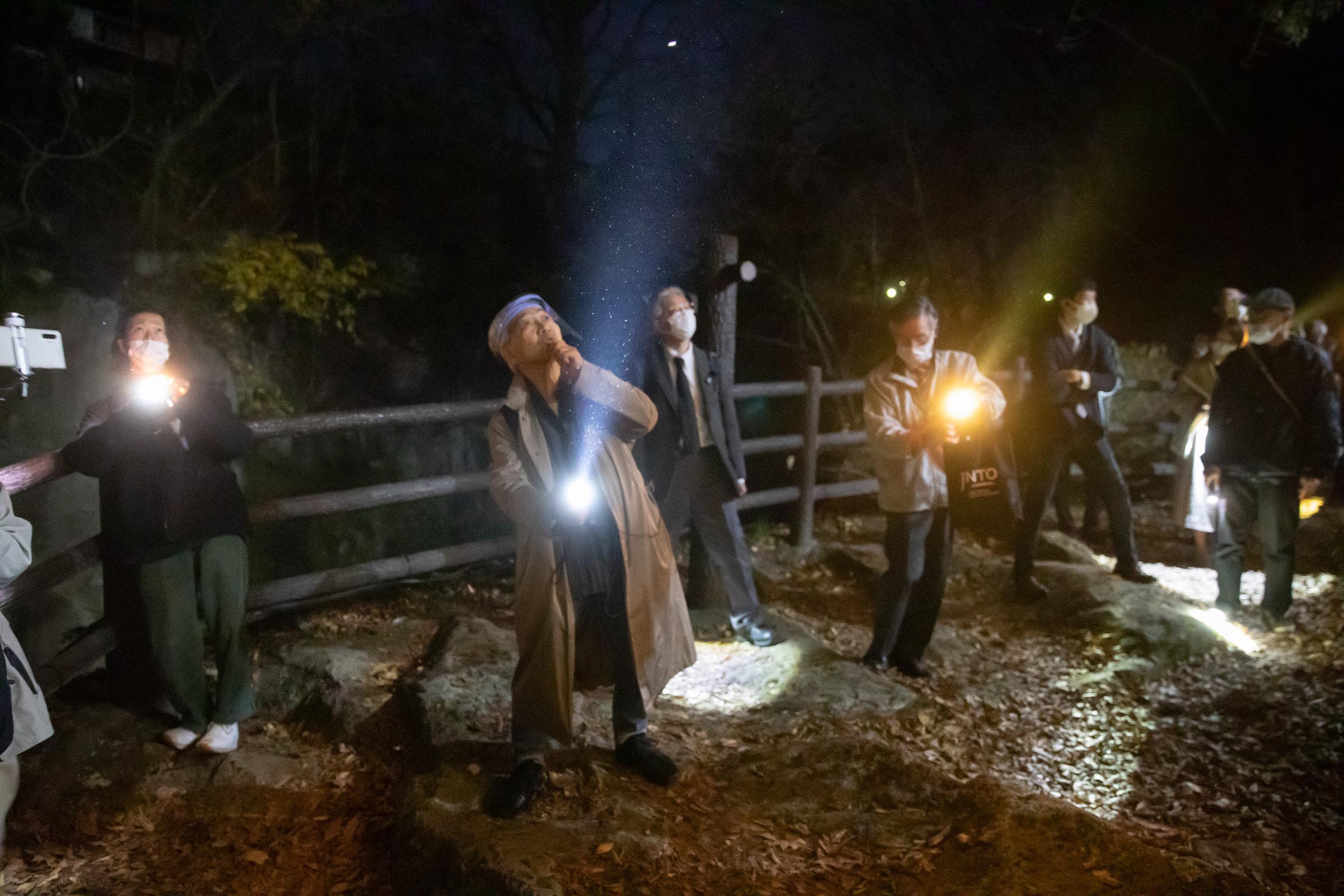
Each participant conducted experiments with a flashlight and color filters in hand
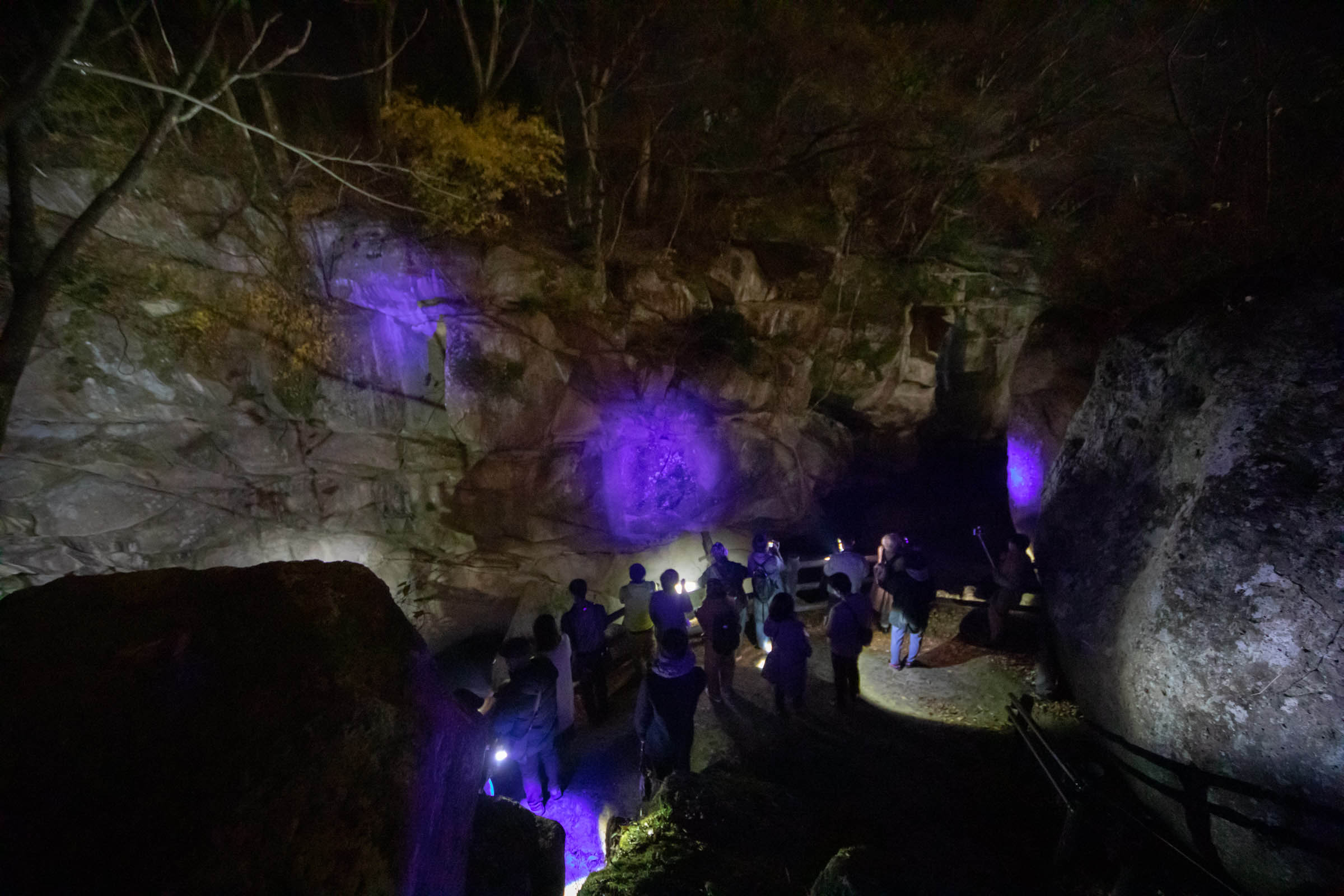
Changing the colors for the light-up. Participants experienced the different impressions each color created
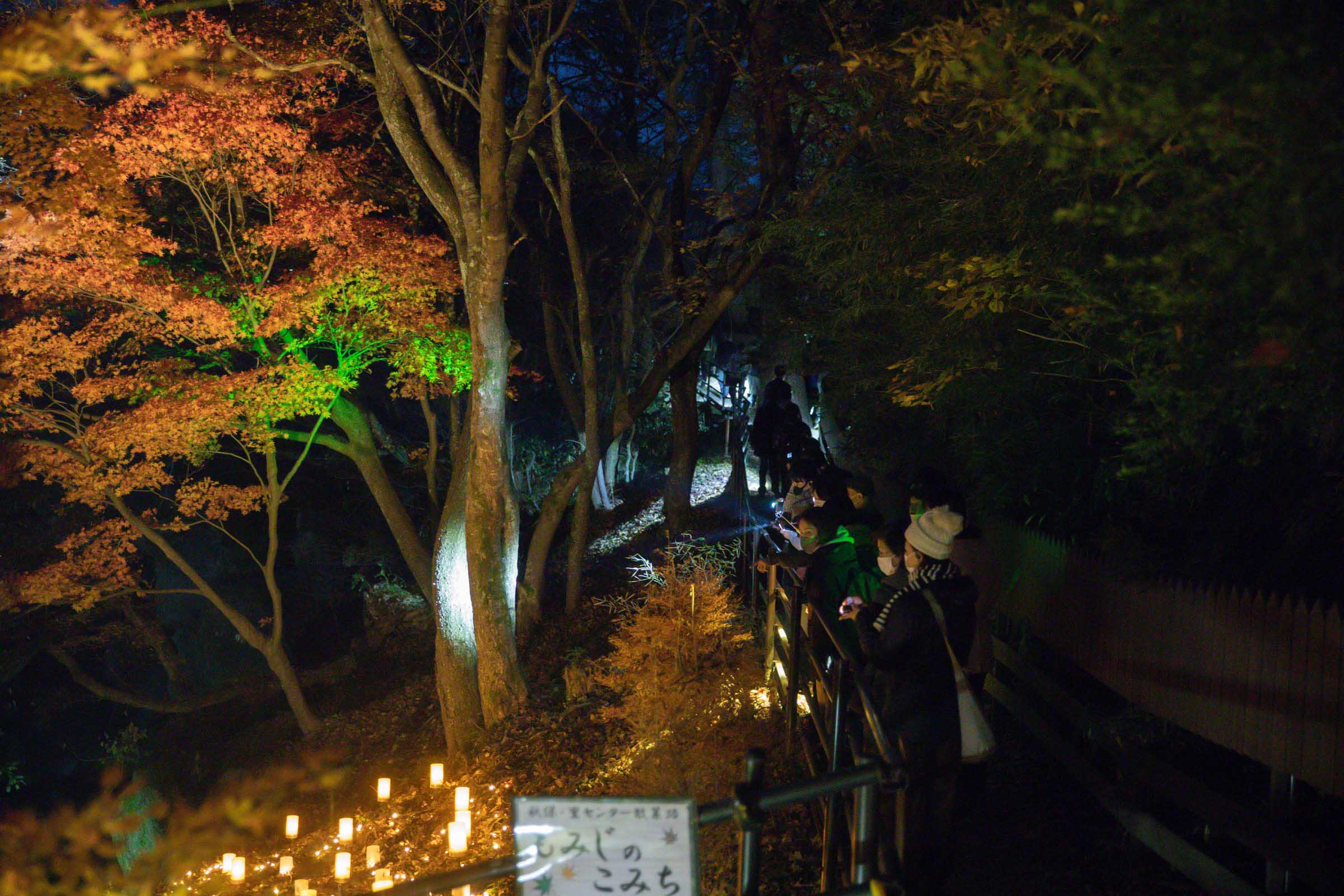
Along the way, we also stopped to observe an installation created for the event
We conducted about 60 minutes of lighting experiments, then headed to the reflection session venue. On the way, we stopped by some installations created for the event and shared our impressions.
During the reflection session, we reviewed the photos taken during the experiments. Many participants said that although they had the desire to try lighting up the area, they didn’t know where to start. By experimenting together and exchanging ideas during the walk, they were able to discover many new insights. There were also several positive comments, including a strong desire to hold similar workshops on a regular basis.
Discussions also covered areas for improvement. Participants recognized that beyond adding lighting, many issues could be resolved simply by making slight adjustments to existing fixtures.
Hearing directly from locals about their hopes and concerns regarding the future of the town’s nightscape made this a truly valuable experience. We hope to return next year to hold a new type of workshop in collaboration once again. (Noriko Higashi)
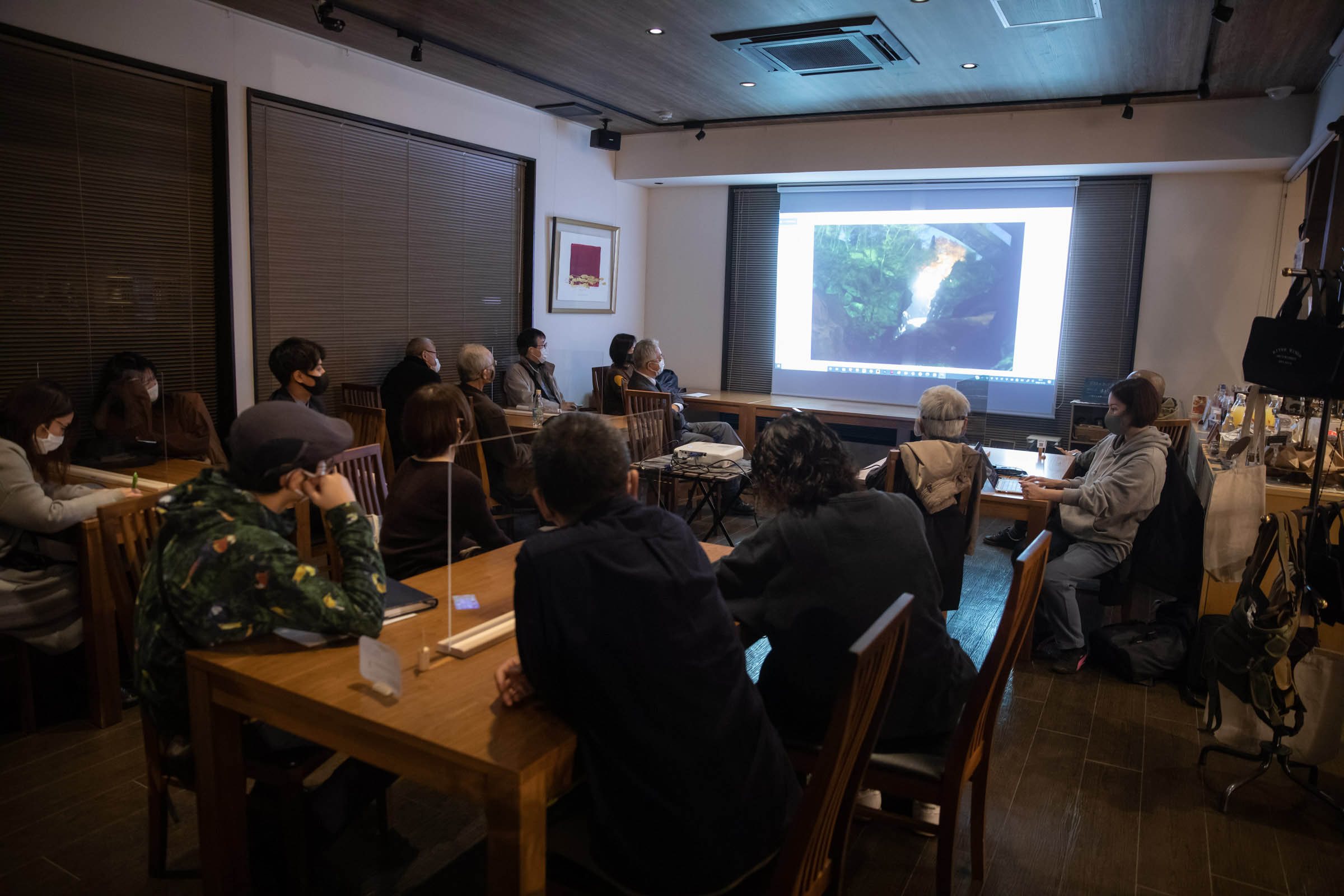
During the review meeting, we reflected on the experiments and exchanged opinions
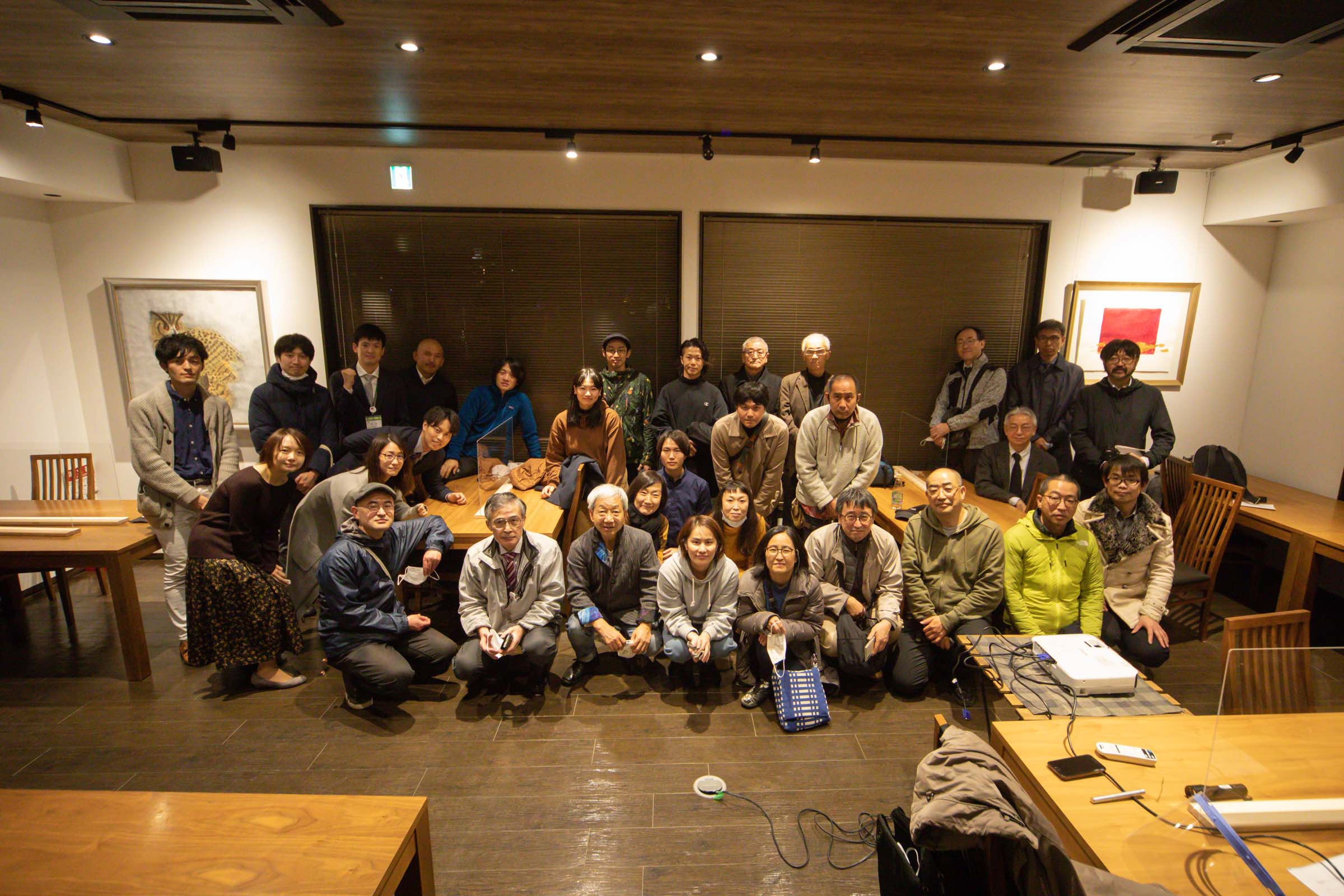
The number of participants was limited, resulting in a gathering of about 30 local residents





